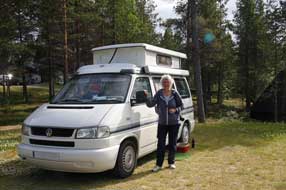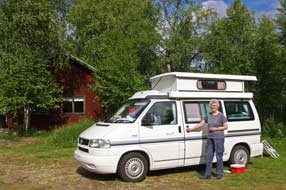|
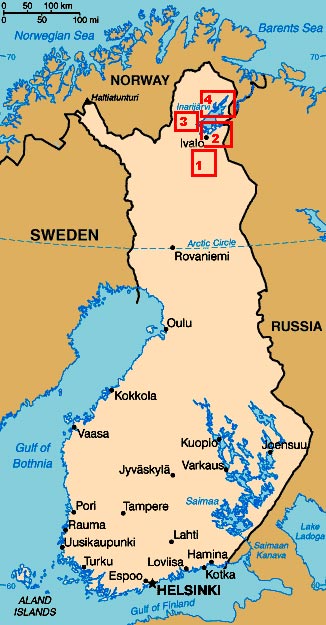 CAMPING
IN FINLAND 2015 - Finnish Lapland - Urho Kekkonen National Park, Nellim and Russian border, Ivalo
and Inari, Lemmenjoki National Park, Kaamanen, Lake Inarijärvi and Sevettijärvi,
Norwegian Border at Näätamö: CAMPING
IN FINLAND 2015 - Finnish Lapland - Urho Kekkonen National Park, Nellim and Russian border, Ivalo
and Inari, Lemmenjoki National Park, Kaamanen, Lake Inarijärvi and Sevettijärvi,
Norwegian Border at Näätamö:
Ilmakkiaapa Mires bird-watching tower: leaving Sodankylä, we headed north on
Route 4/E75 following the course of the Kitinen River which swelled out into
elongated lakes as it flowed south. Our first stop this morning was 35 miles north
along E75 for the Ilmakkiaapa Mires board-walk
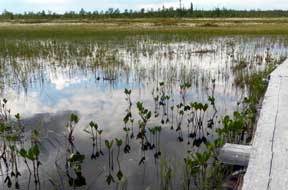 and bird-watching tower.
Today's broken cloud brought sunny spells but also risk of downpours, so in spite
of the now warm weather, we kitted up with cagoules and midge helmets. The
route out to the bird-watching tower (Lintutorni in Finnish) was
via a curving 450m long board-walk across the marshes, and from the information
panel we learnt a new word - flarks - meaning depressions of standing water
across the marsh. The mires experienced so far had been semi-solid areas of
continuous sphagnum, sometimes vegetation-covered; here at Ilmakkiaapa, the
protected marshland, restored to its undrained state had open areas of deep,
standing water which in Springtime floods might overflow the board-walk. These
flooded depressions in the mire, dotted with Bogbeans and Rannoch Rush, are
called flarks (see left). Gingerly we crossed the flooded flarks at the start of
the board-walk, and continued across the broader sphagnum-covered area of the
mire (Photo 1 - Ilmakkiaapa Mires). and bird-watching tower.
Today's broken cloud brought sunny spells but also risk of downpours, so in spite
of the now warm weather, we kitted up with cagoules and midge helmets. The
route out to the bird-watching tower (Lintutorni in Finnish) was
via a curving 450m long board-walk across the marshes, and from the information
panel we learnt a new word - flarks - meaning depressions of standing water
across the marsh. The mires experienced so far had been semi-solid areas of
continuous sphagnum, sometimes vegetation-covered; here at Ilmakkiaapa, the
protected marshland, restored to its undrained state had open areas of deep,
standing water which in Springtime floods might overflow the board-walk. These
flooded depressions in the mire, dotted with Bogbeans and Rannoch Rush, are
called flarks (see left). Gingerly we crossed the flooded flarks at the start of
the board-walk, and continued across the broader sphagnum-covered area of the
mire (Photo 1 - Ilmakkiaapa Mires).
|
Click on 4 highlighted areas of
map
for
details of
Finnish Lapland |
 |
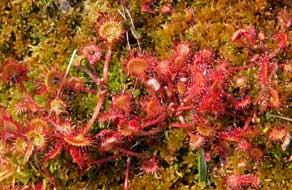 The
board-walk was lined with Bog Rosemary the flowers now past, and the drier
carpets of sphagnum supported huge patches of insectivorous Sundew, normally
only found in tiny isolated plants but here growing in the largest colony of
Sundew ever seen (see left), with Cranberry flowers nearby. The board-walk curved around to
a wetter area of sphagnum where frilly-flowered Bogbeans grew up through the
moss. Further on, Cloudberry grew alongside the boards, the fruit just beginning
to ripen, with masses of Cranberry flowers, growing in huge clumps across the
sphagnum (Photo
2 - Cranberry flowers). The two widths of board was just wide enough for us to stretch out for
close-up photos of all these lovely floral specimens. The
board-walk was lined with Bog Rosemary the flowers now past, and the drier
carpets of sphagnum supported huge patches of insectivorous Sundew, normally
only found in tiny isolated plants but here growing in the largest colony of
Sundew ever seen (see left), with Cranberry flowers nearby. The board-walk curved around to
a wetter area of sphagnum where frilly-flowered Bogbeans grew up through the
moss. Further on, Cloudberry grew alongside the boards, the fruit just beginning
to ripen, with masses of Cranberry flowers, growing in huge clumps across the
sphagnum (Photo
2 - Cranberry flowers). The two widths of board was just wide enough for us to stretch out for
close-up photos of all these lovely floral specimens.
The bird-watching tower at the far end of the
board-walk looked out westwards over Ilmakkijärvi lake, but there was not a
trace of bird-life to be seen at this time of year other than a lone Grey-headed
Wagtail perched on top of a small pine tree growing from the marshland (Photo 3 - Grey-headed Wagtail).
But dark storm clouds were advancing from the west threatening a downpour, and
we hurried back around the board-walk to continue our journey. Despite the
disappointing absence of birdlife, we had enjoyed a wealth of marshland flora.
The attached
Wild Flora of Finnish Lapland gives a photo-gallery of the flora photographed
during our time in Lapland.
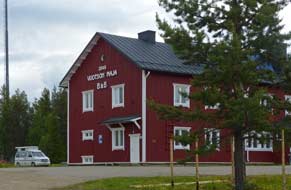 Vuotson Maja Inn/Camping: following
the Kitinen River which flowed through a linked series of lakes, the Route 4
highway took us northwards; reaching the Sámi reindeer-herding village of Vuotso, we spotted a sign for the Vuotson Maja B&B/Camping, and pulled in
to investigate. There had been an inn on the E75 Lapland road here at Vuotso
since 1949 (see left); the friendly owners had newly taken over and were in process of
renovating the accommodation. Although the sign promoted camping, this would
not be fully ready until next year; we were however most welcome to camp on what
was still a rough patch of ground behind the inn and use the facilities inside
the house. Since there was no other campsite between here and Ivalo (other than
the grubby place at Vuotson Maja Inn/Camping: following
the Kitinen River which flowed through a linked series of lakes, the Route 4
highway took us northwards; reaching the Sámi reindeer-herding village of Vuotso, we spotted a sign for the Vuotson Maja B&B/Camping, and pulled in
to investigate. There had been an inn on the E75 Lapland road here at Vuotso
since 1949 (see left); the friendly owners had newly taken over and were in process of
renovating the accommodation. Although the sign promoted camping, this would
not be fully ready until next year; we were however most welcome to camp on what
was still a rough patch of ground behind the inn and use the facilities inside
the house. Since there was no other campsite between here and Ivalo (other than
the grubby place at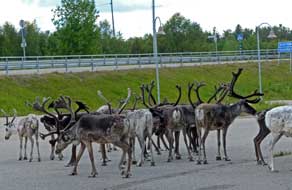 Tankavaara gold-mining museum), we gladly accepted their
hospitality and settled in, with the sultry weather attracting swarms of midges
which filled the camper. Although there was no kitchen, the Vuotson Maja's
WC/showers were a homely luxury, and wi-fi was available in the Inn's reception.
Once the camping area is properly laid out, this would make a welcoming and
worthwhile Lapland stop-over on the E75 between Sodankylä and Ivalo, and
convenient for the Urho Kekkonen National Park where we planned to walk
tomorrow. Tankavaara gold-mining museum), we gladly accepted their
hospitality and settled in, with the sultry weather attracting swarms of midges
which filled the camper. Although there was no kitchen, the Vuotson Maja's
WC/showers were a homely luxury, and wi-fi was available in the Inn's reception.
Once the camping area is properly laid out, this would make a welcoming and
worthwhile Lapland stop-over on the E75 between Sodankylä and Ivalo, and
convenient for the Urho Kekkonen National Park where we planned to walk
tomorrow.
The following morning, before setting off northwards again, we walked across to
Vuotso village. Herds of local fully-antlered reindeer ambled along the road,
bringing traffic on the busy E75 to a halt. The village shop-cum-filling station (kylä-kauppa
in Finnish) was well-stocked with both foodstuffs and hardware, and served as a coffee shop/social centre; here we learnt that Vuotso is the
southernmost of the Lapland Sámi communities with around 170 permanent residents
who make their living from reindeer-herding and tourism. As well as its shop,
the village has a school and older youngsters go to college in Ivalo, Sodankylä
and even Rovaniemi. Reindeer wandered through the village (see right), and 2 of the gentle
beast grazed unperturbed outside the reindeer meat factory-shop (Photo 4 - Vuotso Reindeer meat factory-shop).
Siberian Jay Nature Trail in Urho Kekkonen National Park:
6kms north on E75, we parked at the Metsähallitus Tankavaara Visitor Centre, and
kitted up for the 6km long Kuukkeli Luontopolku (Siberian Jay Nature Trail) which climbs to the summit of
Pikku Tankavaara fell (Click here for
Siberian Jay Nature Trail map). The National Park's emblem
incorporates the Golden Eagle (see below left). The path rose steadily up through
pine and candle-spruce forest, with a lush ground cover of Bilberry,
Bog-Bilberry, Crowberry and Lingonberry whose lovely pink flowers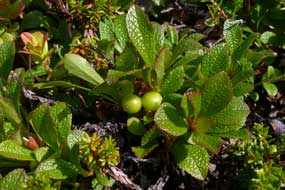 were still in
bud. We soon began to encounter the distinctive Cow Wheat which we had seen for
the first time on this walk in 2012 and which for us will always be associated with the Urho
Kekkonen National Park (Photo 5 - Common Cow Wheat).
During their 1944 retreat from Lapland, the occupying Germans had fortified a
defensive line on the Tankavaara fells to impede Finnish troops advancing along
the road below. This defensive action on these forested fell-sides lasted for a
week, allowing the Germans time to evacuate their forces from Petsamo to Ivalo
and retreat towards Northern Norway. All up the Tankavaara path, traces of WW2
trenches and gun emplacements survive. were still in
bud. We soon began to encounter the distinctive Cow Wheat which we had seen for
the first time on this walk in 2012 and which for us will always be associated with the Urho
Kekkonen National Park (Photo 5 - Common Cow Wheat).
During their 1944 retreat from Lapland, the occupying Germans had fortified a
defensive line on the Tankavaara fells to impede Finnish troops advancing along
the road below. This defensive action on these forested fell-sides lasted for a
week, allowing the Germans time to evacuate their forces from Petsamo to Ivalo
and retreat towards Northern Norway. All up the Tankavaara path, traces of WW2
trenches and gun emplacements survive.
The path steepened up through the tall, shapely spruces,
which have evolved their slender candle-shape to avoid damage from the heavy
weight of winter crown snow-load. The forest eventually thinned as we approached the upper height
limit for pines, and here dwarf mountain-birches, low juniper bushes and scattered
spruce saplings replaced the conifers. With the sun now shining brightly, we
found the rocky
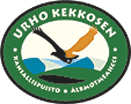 remains of a German WW2 gun emplacement to sit for our lunch
sandwiches, looking out across the tree tops below to the distant fells. As we
resumed our climb, alongside the path we found patches of Alpine Bearberry with
green unripe fruits growing among the Crowberry and Bilberry (see right), and the distinctive
strands of Twin Flower leaves with tiny flower buds (Photo
6 - Twin Flower buds). The 425m high summit plateau of Pikku Tankavaara
fell is crowned by a wooden observation tower (Näkätorni in Finnish), and
from the top of this we could look out to the distant surrounding fells over the
tall candle-spruces which were scattered across the plateau, their usual shapely
outlines here deformed by winter snow damage (Photo
7 - Pikku Tankavaara fell summit plateau). remains of a German WW2 gun emplacement to sit for our lunch
sandwiches, looking out across the tree tops below to the distant fells. As we
resumed our climb, alongside the path we found patches of Alpine Bearberry with
green unripe fruits growing among the Crowberry and Bilberry (see right), and the distinctive
strands of Twin Flower leaves with tiny flower buds (Photo
6 - Twin Flower buds). The 425m high summit plateau of Pikku Tankavaara
fell is crowned by a wooden observation tower (Näkätorni in Finnish), and
from the top of this we could look out to the distant surrounding fells over the
tall candle-spruces which were scattered across the plateau, their usual shapely
outlines here deformed by winter snow damage (Photo
7 - Pikku Tankavaara fell summit plateau).
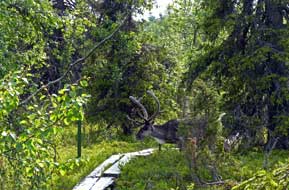 Crossing
the summit boulder-field, the path began the descent into birch trees again,
passing lovely patches of Chickweed Wintergreen and Dwarf Cornel
flowers
sheltering around the base of birches (see left). The path dropped down through
the birches to reach the spruce level again, and as the gradient Crossing
the summit boulder-field, the path began the descent into birch trees again,
passing lovely patches of Chickweed Wintergreen and Dwarf Cornel
flowers
sheltering around the base of birches (see left). The path dropped down through
the birches to reach the spruce level again, and as the gradient
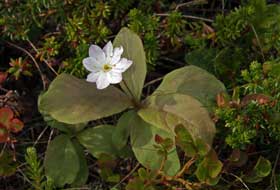 slackened here
the long board-walk began. This wove its way through increasingly dense conifer
woods, and as we advanced we were surprised to meet a fully-antlered reindeer
coming up the board-walk; equally startled, he scampered off into the forest
giving us a wide berth (see right). The forest opened up as the board-walk
crossed open sedge mire in the water gathering area of the upper Hopiaoja stream.
The board-walk continued through a drier forested area to reach a laavu shelter,
and followed the stream through denser woodland. Re-crossing the Hopiaoja steam
on board-walk along a marshy valley, we passed more Cloudberry and some Spotted
Orchids. The path led back through pine forest to the Visitor Centre where
another reindeer grazed the track side verges, this time indifferent to our
presence (Photo
8 - Grazing reindeer). slackened here
the long board-walk began. This wove its way through increasingly dense conifer
woods, and as we advanced we were surprised to meet a fully-antlered reindeer
coming up the board-walk; equally startled, he scampered off into the forest
giving us a wide berth (see right). The forest opened up as the board-walk
crossed open sedge mire in the water gathering area of the upper Hopiaoja stream.
The board-walk continued through a drier forested area to reach a laavu shelter,
and followed the stream through denser woodland. Re-crossing the Hopiaoja steam
on board-walk along a marshy valley, we passed more Cloudberry and some Spotted
Orchids. The path led back through pine forest to the Visitor Centre where
another reindeer grazed the track side verges, this time indifferent to our
presence (Photo
8 - Grazing reindeer).
E75 Lapland Highway north to Ivalo: as we set off again northward on E75, the bright sun of
late afternoon lit the shapely candle spruces lining the highway
(Photo
9 - Candle-spruces). The road passed over high, open and utterly exposed
fell-land, with snow-fencing to protect the highway from drifting winter snow
(see right). Eventually the road descended to the lower forested Ivalojoki
valley, the river draining a huge area of wilderness fell, uninhabited but for
isolated Sámi reindeer-herding settlements and meandering on its lower
course into Lake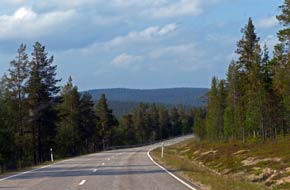 Inarijärvi. Approaching Ivalo, we reached tonight's campsite, Ivalo River
Camping, set by a filling station right alongside the busy highway. The reception
staff were friendly and welcoming, but when it came to finding a viable space to
camp, the place's inadequacies became evident. The riverside camping area across
the road was overwhelmed by traffic noise, and we eventually settled on a
limited grassy area by the huts. The welcome was pleasant and price cheap but
you get what you pay for: utterly basic facilities and limited camping space,
and traffic noise from the nearby main road. It would serve for one night, and
our supper of elk meat balls from Kylmänen cooked in a creamy lingonberry sauce
cheered the evening. Tonight was one of only four occasions this year when we
might experience the Midnight Sun; late evening, the sun re-emerged from cloud-cover to shine above the Ivalojoki river, but we were too weary for late
photographs and turned in.
Inarijärvi. Approaching Ivalo, we reached tonight's campsite, Ivalo River
Camping, set by a filling station right alongside the busy highway. The reception
staff were friendly and welcoming, but when it came to finding a viable space to
camp, the place's inadequacies became evident. The riverside camping area across
the road was overwhelmed by traffic noise, and we eventually settled on a
limited grassy area by the huts. The welcome was pleasant and price cheap but
you get what you pay for: utterly basic facilities and limited camping space,
and traffic noise from the nearby main road. It would serve for one night, and
our supper of elk meat balls from Kylmänen cooked in a creamy lingonberry sauce
cheered the evening. Tonight was one of only four occasions this year when we
might experience the Midnight Sun; late evening, the sun re-emerged from cloud-cover to shine above the Ivalojoki river, but we were too weary for late
photographs and turned in.
The Arctic Ocean Road to Nellim:
first stop this morning was the S-Market in the centre of Ivalo for a major
provisions stock-up for our 4 day stay in the isolated settlement of Nellim. As
usual on a Saturday morning, the supermarket was busy with Russian cross-border
shoppers from Murmansk, just 303 kms distance from Ivalo beyond the Raja-Jooseppi
border-crossing. At weekends, people from the Murmansk region flock across the
border to Ivalo shopping for both foodstuffs and consumer goods which simply are
not available for most citizens in Putin's Russia. Having completed our
provisions shopping, we turned off onto Route 91 at Ivalo's central cross-roads
following the road-sign to Murmansk. A sign board part-way along nostalgically
labels this area as Pikku Petsamo (Little Petsamo), recalling that this road led
originally to Finnish Petsamo on the White Sea coast before Stalin's land theft
after WW2. 7kms along, the Murmansk road turned off and Route 969 continued ahead for a further 5 kms to Keväjärvi village where the tarmac
ended (click on Map 2 at top right of News Page for details of our route). Route
969 continued beyond the village as a gravel road for the next 30 kms, winding
and undulating through hilly, largely uninhabited forested terrain along the
eastern shore of Lake Inarijärvi.
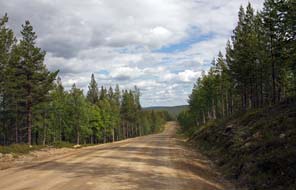 This scarcely populated area around the NE
shore of Inarijärvi was originally settled by Inari Sámi reindeer-herders in the
1870s. One of the farms was named Nellim which gave its name to the scattered
farming settlement around Paatsjoki, the river which flows from Lake Inarijärvi
at its NE corner and marks the current border between Finland, Russia and Norway;
the river is
known in Norwegian as the Pasvik. Finns began moving into this area during
the 1920~30s with the development of intensive logging industry. The 1920 Treaty
of Tartu between the newly independent Finland and Lenin's USSR had originally
defined the border between the two countries. Through this treaty, Finland
had acquired the whole of the Petsamo region from Lake Inarijärvi
north-eastwards along the banks of the Paatsjoki/Pasvik River right through to
the port of Liinahamari on the Pechenga fjord-inlet of the Barents Sea. This
opening to the White Sea, together with extensive logging forests and the
Petsamo region's mineral wealth created enormous economic opportunities for
Finland. To open up this remote region and exploit its timber and mineral
resources, a major road construction was planned all the way
across Lapland from Rovaniemi, along the This scarcely populated area around the NE
shore of Inarijärvi was originally settled by Inari Sámi reindeer-herders in the
1870s. One of the farms was named Nellim which gave its name to the scattered
farming settlement around Paatsjoki, the river which flows from Lake Inarijärvi
at its NE corner and marks the current border between Finland, Russia and Norway;
the river is
known in Norwegian as the Pasvik. Finns began moving into this area during
the 1920~30s with the development of intensive logging industry. The 1920 Treaty
of Tartu between the newly independent Finland and Lenin's USSR had originally
defined the border between the two countries. Through this treaty, Finland
had acquired the whole of the Petsamo region from Lake Inarijärvi
north-eastwards along the banks of the Paatsjoki/Pasvik River right through to
the port of Liinahamari on the Pechenga fjord-inlet of the Barents Sea. This
opening to the White Sea, together with extensive logging forests and the
Petsamo region's mineral wealth created enormous economic opportunities for
Finland. To open up this remote region and exploit its timber and mineral
resources, a major road construction was planned all the way
across Lapland from Rovaniemi, along the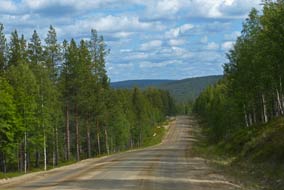 eastern shore of Inarijärvi, through
the farming hamlet of Nellim, and along the eastern bank of the Paatsjoki/Pasvik
River, connecting right through the Petsamo region to Liinahamari port on the
Barents Sea coast. Work began in 1916, and delayed by wars, the Arctic Ocean
Road (Jäämerentie) as it was called was completed in 1931. Road
construction was entirely by manual labour, providing employment for gangs of
men working plots of 100 length:
Click here for map of Arctic Ocean Road 1920~39. eastern shore of Inarijärvi, through
the farming hamlet of Nellim, and along the eastern bank of the Paatsjoki/Pasvik
River, connecting right through the Petsamo region to Liinahamari port on the
Barents Sea coast. Work began in 1916, and delayed by wars, the Arctic Ocean
Road (Jäämerentie) as it was called was completed in 1931. Road
construction was entirely by manual labour, providing employment for gangs of
men working plots of 100 length:
Click here for map of Arctic Ocean Road 1920~39.
The road opened up the Nellim and Petsamo
region for
an extensive logging industry during the 1920~30s, and with work shortages this
attracted workers from across Finland. Logs were floated from Inarijärvi into the mouth of the Paatsjoki/Pasvik at Virtaniemi, and along the river
through the Pasvik valley to a huge sawmill at Jakobsnes north of Kirkenes. Inns
were built along the Arctic Ocean Road at one day travel intervals to
accommodate the increasing
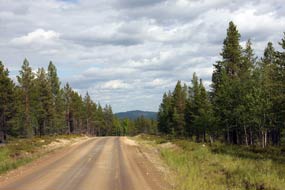 numbers of not only workers but travellers to the
northern region, including an inn at what is now the border-post at Virtaninemi.
In addition to logging, the Road also opened up the Petsamo
region for exploitation of its mineral wealth: the mining town at Nikel (called
Kolosjoki by the Finns) was established in the 1930s with a rail link for mined
nickel ore to the port of Liinahamari. With the Russian invasion of Petsamo in
1939 and subsequent Continuation War brought to an end by the 1944 Treaty of
Moscow, all of this came to an end. Ever open to seizing opportunities, Stalin
forcibly annexed the entire Petsamo salient for its logging and mineral wealth,
including the Road from Nellim all the way to Liinahamari on the Barents Sea and
the mines and smelters at Nikel:
Click here for map of Petsamo 1940~47. numbers of not only workers but travellers to the
northern region, including an inn at what is now the border-post at Virtaninemi.
In addition to logging, the Road also opened up the Petsamo
region for exploitation of its mineral wealth: the mining town at Nikel (called
Kolosjoki by the Finns) was established in the 1930s with a rail link for mined
nickel ore to the port of Liinahamari. With the Russian invasion of Petsamo in
1939 and subsequent Continuation War brought to an end by the 1944 Treaty of
Moscow, all of this came to an end. Ever open to seizing opportunities, Stalin
forcibly annexed the entire Petsamo salient for its logging and mineral wealth,
including the Road from Nellim all the way to Liinahamari on the Barents Sea and
the mines and smelters at Nikel:
Click here for map of Petsamo 1940~47.
One significant social affect of Stalin's
forcible annexation of Finnish Petsamo was the disastrous impact on the Skolt
Sámi indigenous population whose traditional reindeer herding lands had for
generations spanned the Petsamo and Kola peninsulas, where they had lived a semi-nomadic life-style
for generations. In 1945 they were forcibly ejected from their
homelands in the now Russian occupied Petsamo, and were resettled by Finland in
areas around Inarijärvi at Sevettijärvi and Nellim. From its early beginnings as reindeer farming settlements in late 19th
century, Nellim had seen a rapid but brief
rise as an early 20th century boom frontiers-ville with the logging
industry and development of the Arctic Ocean Road. But closure of the road and
the shifted border with Russia in 1944 with USSR's seizure of Petsamo, and
decline of the logging, brought a equally rapid end to the boom. The remote
village of Nellim as it is today, isolated at the end of the road-to-nowhere at
the closed
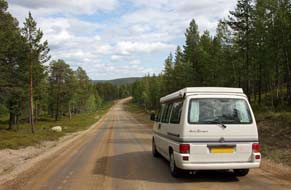 border with Russia, still retains its 3 cultures of the Inari-Sámi
indigenous settlers, the descendents of the 1920s Finnish settlers, and the 35
families of Skolt Sámi resettled here in 1948. Nowadays the wilderness tourist
industry has brought some economic revival along with residual farming and
reindeer-herding, but Nellim today has very much a forgotten and end-of-the-road
air. border with Russia, still retains its 3 cultures of the Inari-Sámi
indigenous settlers, the descendents of the 1920s Finnish settlers, and the 35
families of Skolt Sámi resettled here in 1948. Nowadays the wilderness tourist
industry has brought some economic revival along with residual farming and
reindeer-herding, but Nellim today has very much a forgotten and end-of-the-road
air.
Our journey along the residual Arctic Ocean Road to Nellim:
as we drove out for what seemed an unending 30 kms of bumpy, dusty gravel road,
weaving and twisting every-which-way, up and down hills, there was a curious
sense of history travelling the route of the original Arctic Ocean Road, or what
was left of it in this neglected state (Photo
10 - Arctic Ocean Road) (see photos above left and right): it now led to no where but the now
isolated residual settlement of Nellim, and just beyond that the now sealed
border-post at Virtaninemi. There were no views of Lake Inarijärvi, just an
unending vista of boreal forests stretching away into unknown distance (see
right). We
passed several forest-road turnings leading to who-knows-where, and one of the
original inns (maja in Finnish) built along the road. To say the road
surface was rough was certainly no overstatement, and we took it steadily at no
more than 30 mph allowing what little local traffic there was to speed past in a
cloud of dust. Eventually we reached the outskirts of Nellim which was spread
around an inlet of the lake, and turned into the Nellim Erä-hotelli (Wilderness
Hotel).
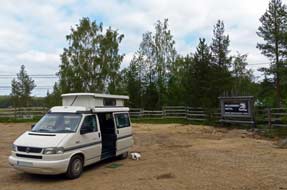 Camping at Nellim Wilderness Hotel:
we had earlier received an email response confirming we could camp here,
and saying they were planning a camping area, but no more than that. At reception
we were greeted hospitably but it was as if, with camping being new, the staff
were unsure how to deal with our request. Facilities were limited to the hotel's
WC/showers and wi-fi, but there were no other cooking facilities except the
lakeside camp-fire hut. After some debate, we eventually agreed a daily rate of
€15 plus a negotiated amount for use of the showers, but what would happen when Camping at Nellim Wilderness Hotel:
we had earlier received an email response confirming we could camp here,
and saying they were planning a camping area, but no more than that. At reception
we were greeted hospitably but it was as if, with camping being new, the staff
were unsure how to deal with our request. Facilities were limited to the hotel's
WC/showers and wi-fi, but there were no other cooking facilities except the
lakeside camp-fire hut. After some debate, we eventually agreed a daily rate of
€15 plus a negotiated amount for use of the showers, but what would happen when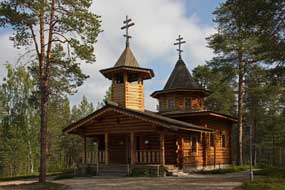 we came to settle up remained to be seen. The newly laid-out camping area was
nothing more than a fenced area of loose, sandy gravel with power supplies
along the side, stark and unappealing like a semi-derelict building site with
the debris of its recent construction littering the sandy surface. Having this
summer laid out this dreary patch of sandy dereliction that passed for a
campsite, it seemed that the hotel was relying on next winter's weight of snow
to consolidate the sand into something usable. In the meantime we settled in to
make the best of a poor lot if we were to camp at Nellim for our 4 days stay.
However basic, limited and grubby, at least there was somewhere to camp (see
left).
we came to settle up remained to be seen. The newly laid-out camping area was
nothing more than a fenced area of loose, sandy gravel with power supplies
along the side, stark and unappealing like a semi-derelict building site with
the debris of its recent construction littering the sandy surface. Having this
summer laid out this dreary patch of sandy dereliction that passed for a
campsite, it seemed that the hotel was relying on next winter's weight of snow
to consolidate the sand into something usable. In the meantime we settled in to
make the best of a poor lot if we were to camp at Nellim for our 4 days stay.
However basic, limited and grubby, at least there was somewhere to camp (see
left).
Exploring Nellim and St Tryphon's Orthodox
Church:
the gloomily overcast weather the following morning matched the depressingly
dreary surroundings of where we were camped, and we delayed the start of our first
day of exploration around Nellim, hoping the weather would improve; it didn't!
We drove around into Nellim village and turned off opposite the little harbour
to find the Skolt Orthodox church.
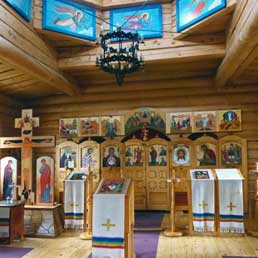 The prefabricated wooden dwellings along the
lane looked probably to be those built hastily after WW2 to accommodate the
Skolt Sámi families displaced from Petsamo. The church was 1km up a side lane
into the forest, a truly wilderness church built in 1987 from logs to resemble
the old Petsamo convent church, and dedicated to St Tryphon of Petsamo (Photo
11 - St Tryphon's Orthodox Church at Nellim) (see above right). Near to the church stood a memorial to
the war in Petsamo and its aftermath. A local lady had just opened the church
enabling us to photograph the iconostasis (see left) (Photo
12 - Iconostasis), and we used the only word of the
Skolt Sámi language we knew (which we had been taught in 2012 at the Sámi
Parliament in Inari) - Spässeb (cf
Russian Spasibo) The prefabricated wooden dwellings along the
lane looked probably to be those built hastily after WW2 to accommodate the
Skolt Sámi families displaced from Petsamo. The church was 1km up a side lane
into the forest, a truly wilderness church built in 1987 from logs to resemble
the old Petsamo convent church, and dedicated to St Tryphon of Petsamo (Photo
11 - St Tryphon's Orthodox Church at Nellim) (see above right). Near to the church stood a memorial to
the war in Petsamo and its aftermath. A local lady had just opened the church
enabling us to photograph the iconostasis (see left) (Photo
12 - Iconostasis), and we used the only word of the
Skolt Sámi language we knew (which we had been taught in 2012 at the Sámi
Parliament in Inari) - Spässeb (cf
Russian Spasibo) meaning Thank you. We walked over to the cemetery
alongside the church where the graves were covered with lichen as at Sevettijärvi
and marked with Orthodox crosses (Photo
13 - Orthodox graves) (see right). The Skolt family names were all Russian-sounding, Jefremoff, Sverloff and Titoff; somehow the bare facts recorded on the
headstones - born Petsamo 1927, died Nellimjärvi 1986 - conveyed the entire
tragedy of the families of Skolts whose traditions and whole way of life had
been so brutally disrupted by war. meaning Thank you. We walked over to the cemetery
alongside the church where the graves were covered with lichen as at Sevettijärvi
and marked with Orthodox crosses (Photo
13 - Orthodox graves) (see right). The Skolt family names were all Russian-sounding, Jefremoff, Sverloff and Titoff; somehow the bare facts recorded on the
headstones - born Petsamo 1927, died Nellimjärvi 1986 - conveyed the entire
tragedy of the families of Skolts whose traditions and whole way of life had
been so brutally disrupted by war.
End of the Arctic Ocean Road at the
sealed Russian border beyond Nellim: back into the village, we turned
north-eastwards and pressed on slowly beyond Nellim along the roughly gravelled
road; the route of the original Arctic Ocean Road crossed the rapids of the
Nellimjoki river down which logs were once floated from Nellimjärvi. Continuing
for a further 7 kms, the road became even rougher, passing through truly
desolate wilderness terrain with just the power line out to the Virtaniemi
border-post. Around the point where a side-road branched off to the bridge
spanning the mouth of the Paatsjoki river, the border zone began, indicated by
yellow markers on trees on each side of the road, and 1 km further we reached
the Virtaniemi border-post. Here the road ended, and the way ahead was barred by
padlocked gates, fenced on ether side and the
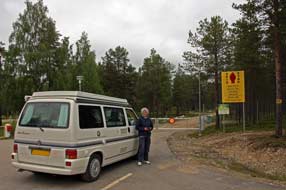 usual No entry without permit
warning signs (Photo
14 - End of the former Arctic Ocean Road) (see below left). The dull,
gloomy light and desolate state of the surrounding wilderness terrain added to
the depressing atmosphere of the place, recalling the loss of Petsamo and
sealing of the shifted border. usual No entry without permit
warning signs (Photo
14 - End of the former Arctic Ocean Road) (see below left). The dull,
gloomy light and desolate state of the surrounding wilderness terrain added to
the depressing atmosphere of the place, recalling the loss of Petsamo and
sealing of the shifted border.
Back along the lane from the border, we turned
off down to the Paatsjoki bridge; the on-going road beyond became impassable
forestry track which led ultimately in 30 kms to the Three Countries Border
Monument (Muotkavaara in Finnish, Treriksrøysa in Norwegian), the
remote and inaccessible meeting-point of the borders of Finland, Norway and
Russia. From the bridge which spans the wide river at the point where it flows
from Lake Inarijärvi, we could look along the on-going river which crosses the
Russian border just 3 kms northwards, and continues towards the salient of the Øvre Pasvik
Valley where we had camped last year
(see
our 2014 log); the river forms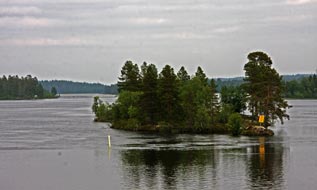 the border between
Norway and now Russian Petsamo with the mining town of Nikel. Just beyond the border-line but out of sight from us at the Paatsjoki bridge, a series of 3 Russian hydro-electric dams at Rajakoski,
Jäniskoski and Kaitakoski now control the water levels in Lake Inarijärvi.
Despite the poor light, we took our photos from the bridge looking northwards to
where the river crosses the border into Russian territory 3 kms downstream, with
the border-zone warning signs just visible on a river island and on the river
banks (see right) (Photo
15 - Paatsjoki bridge). the border between
Norway and now Russian Petsamo with the mining town of Nikel. Just beyond the border-line but out of sight from us at the Paatsjoki bridge, a series of 3 Russian hydro-electric dams at Rajakoski,
Jäniskoski and Kaitakoski now control the water levels in Lake Inarijärvi.
Despite the poor light, we took our photos from the bridge looking northwards to
where the river crosses the border into Russian territory 3 kms downstream, with
the border-zone warning signs just visible on a river island and on the river
banks (see right) (Photo
15 - Paatsjoki bridge).
Returning to Nellim, we searched in vain for
the Travellers' Cross, the Orthodox cross erected by the Skolts as a memorial to
those of their kin left behind buried in the lost homelands of Petsamo. It also
commemorates the work of reconstruction of the area around Nellim after wartime
devastation, and is the starting point for the annual Skolt pilgrimage in August
from St Tryphon's Church Nellim to the sister church at Sevettijärvi. With the
weather still depressingly gloomy we set up camp again at the sandy waste area
that passed for a campsite at the Nellim Wilderness Hotel. The forecast for
tomorrow was still for overcast cloudy conditions; oh for the sun!
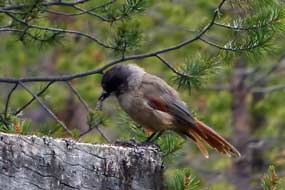 A
walk to the Nellim reconstructed log-flume past the Iron Gates:
the following morning was indeed gloomily overcast again; the best you could say
was that it was not actually raining. Nellim had been our final chance this year to
see the Midnight Sun, but the sun had not actually shone during our 4 days here in this
godforsaken wilderness! We drove 4 kms eastwards along the dirt road beyond Nellim village to the Paksuvuono parking area for the 8 kms round walk out to the
reconstructed log-flume which connected Lakes Nellimjärvi and Keskimöjärvi for
log-floating, recalling Nellim's glory days during the 1920~30s logging era. The
path began along a cart-track and as we moved forwards, we
spotted a large bird flitting among the branches of pine trees with a low
whistling call; Sheila managed to get close-up photos which showed it clearly as
a Siberian Jay (Photo
16 - Siberian Jay) (see left). Not showing the bird's usual indifference to
human presence, this one soon flew off. The track-way continued towards the
narrow, cliff-lined inlet at the end of Nellimjärvi known as the Iron Gates (Rautaportti
in Finnish). This narrow bay of Nellimjärvi is separated from the inner reaches
of Lake Inarijärvi by a low-lying isthmus of land crossed by the Arctic
Ocean Road to Petsamo. This point assumed a strategic importance to protect the
Arctic Ocean Road, and in the lead up to the Winter War in 1939, the Finns
constructed a fortified defence line between the rocky cliffs of the Iron Gates
and along the Road at Lake Matjärvi. During the Interim Peace of 1940~41, the
defence line was further reinforced. As part of the Finnish~German pact during
the Continuation War, the Germans were allowed right of troop movement from the
Kirkenes front along the Arctic Ocean Road to Petsamo as part of the A
walk to the Nellim reconstructed log-flume past the Iron Gates:
the following morning was indeed gloomily overcast again; the best you could say
was that it was not actually raining. Nellim had been our final chance this year to
see the Midnight Sun, but the sun had not actually shone during our 4 days here in this
godforsaken wilderness! We drove 4 kms eastwards along the dirt road beyond Nellim village to the Paksuvuono parking area for the 8 kms round walk out to the
reconstructed log-flume which connected Lakes Nellimjärvi and Keskimöjärvi for
log-floating, recalling Nellim's glory days during the 1920~30s logging era. The
path began along a cart-track and as we moved forwards, we
spotted a large bird flitting among the branches of pine trees with a low
whistling call; Sheila managed to get close-up photos which showed it clearly as
a Siberian Jay (Photo
16 - Siberian Jay) (see left). Not showing the bird's usual indifference to
human presence, this one soon flew off. The track-way continued towards the
narrow, cliff-lined inlet at the end of Nellimjärvi known as the Iron Gates (Rautaportti
in Finnish). This narrow bay of Nellimjärvi is separated from the inner reaches
of Lake Inarijärvi by a low-lying isthmus of land crossed by the Arctic
Ocean Road to Petsamo. This point assumed a strategic importance to protect the
Arctic Ocean Road, and in the lead up to the Winter War in 1939, the Finns
constructed a fortified defence line between the rocky cliffs of the Iron Gates
and along the Road at Lake Matjärvi. During the Interim Peace of 1940~41, the
defence line was further reinforced. As part of the Finnish~German pact during
the Continuation War, the Germans were allowed right of troop movement from the
Kirkenes front along the Arctic Ocean Road to Petsamo as part of the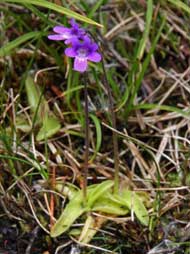 war in the
north. The Germans heavily fortified the Iron Gates cliffs, and in 1944 the
advancing Soviets built opposing fortified positions on the northern side of the
cliffs along Nellimjärvi. There was little active fighting here until the German
retreat when the Iron Gates defence line fought a holding action to delay the
Soviet advance and allow German troops to be withdrawn towards Ivalo. war in the
north. The Germans heavily fortified the Iron Gates cliffs, and in 1944 the
advancing Soviets built opposing fortified positions on the northern side of the
cliffs along Nellimjärvi. There was little active fighting here until the German
retreat when the Iron Gates defence line fought a holding action to delay the
Soviet advance and allow German troops to be withdrawn towards Ivalo.
Our way-marked path branched off by the Iron
Gate cliffs and passed over higher forested ground above an area of low-lying
marsh and a small lake, undulating a zigzagging course over rough fell (Click here for
map of the log-flume path). This was truly wilderness terrain, and we
were grateful for the assurance of the way-markings. By now the midges were
severe and we were forced to wear midge protection (Photo
17 - Midge protection). The path descended to lower marshy ground
skirting around Rytilahti bay at Nellimjärvi. On the moist ground, we found
specimens of insectivorous Common Butterwort, their basal leaves full of insects
being digested (see right), and alongside the path patches of Cloudberry laden
with ripening fruits (Photo
18 - Ripening Cloudberry fruit). Over a shoulder of fell-land, the
path again dropped down to wetter marshy land crossed by board-walk, and now
wove a way through rough forest alongside boulder-fields edging down to the lake.
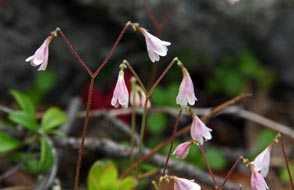 This eventually led to a junction with a forest track-way and around another
small bay of Nellimjärvi close to where we expected to find the exit of the
log-flume. We could hear in the distance the sound of the natural rapids
descending from the higher Lake Keskimöjärvi that the log-flume had been
constructed to bypass for timber-floating. But with all the rough, forested
fell-land around the lake-side, it was difficult to make out where the line of
rapids and parallel
flume actually were, and where the flume's outlet into Nellimjärvi
might be. A sign pointed uphill to a Tulipaikka which translated as
Fire-place; we took this to mean the camp-fire laavu (lean-to shelter) shown
on the map, and assuming this to be towards the top of the flume, we followed
this upwards. As the forest cleared, there ahead was the enormous wooden structure of
the log-flume stretching down the length of the hill-side at a steep angle (Photo
19 - Log-floating flume). This eventually led to a junction with a forest track-way and around another
small bay of Nellimjärvi close to where we expected to find the exit of the
log-flume. We could hear in the distance the sound of the natural rapids
descending from the higher Lake Keskimöjärvi that the log-flume had been
constructed to bypass for timber-floating. But with all the rough, forested
fell-land around the lake-side, it was difficult to make out where the line of
rapids and parallel
flume actually were, and where the flume's outlet into Nellimjärvi
might be. A sign pointed uphill to a Tulipaikka which translated as
Fire-place; we took this to mean the camp-fire laavu (lean-to shelter) shown
on the map, and assuming this to be towards the top of the flume, we followed
this upwards. As the forest cleared, there ahead was the enormous wooden structure of
the log-flume stretching down the length of the hill-side at a steep angle (Photo
19 - Log-floating flume).
The original flume had been constructed at the
height of the 1920~30s period of intensive logging by the Anglo-Norwegian
forestry company STIF to provide a viable route linking the 16m of height
difference between the 2 lakes of Keskimöjärvi and Nellimjärvi, bypassing the
natural water flow down narrow rapids. The log-flume was restored in 1994~5 by the
Finnish National Board of Antiquities, and slopes for 304m in length at an angle
down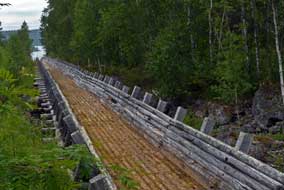 the 16m drop in height between the 2 lakes. The camp-fire laavu was
positioned half-way down the flume, with a platform enabling a clear view into
the flume's now dry trough up and down its length. Clambering up onto the
platform for photos of the flume's structure, we then followed a track
up towards the higher end at Lake Keskimöjärvi. The path was lined with masses
of flourishing Twin Flowers (Photo
20 - Twin Flowers) (see above left), led alongside the upper
section of the flume timber trough which with its sturdy supports stood some 4m
in height. At its top end at Lake Keskimöjärvi, the inlet flow was dry; at the
time of the original flume's operation, the upper lake's outlet into the natural
down-flowing rapids must have been dammed to divert the out-flow into the flume.
Standing here at the top end the 16m drop in height between the 2 lakes. The camp-fire laavu was
positioned half-way down the flume, with a platform enabling a clear view into
the flume's now dry trough up and down its length. Clambering up onto the
platform for photos of the flume's structure, we then followed a track
up towards the higher end at Lake Keskimöjärvi. The path was lined with masses
of flourishing Twin Flowers (Photo
20 - Twin Flowers) (see above left), led alongside the upper
section of the flume timber trough which with its sturdy supports stood some 4m
in height. At its top end at Lake Keskimöjärvi, the inlet flow was dry; at the
time of the original flume's operation, the upper lake's outlet into the natural
down-flowing rapids must have been dammed to divert the out-flow into the flume.
Standing here at the top end
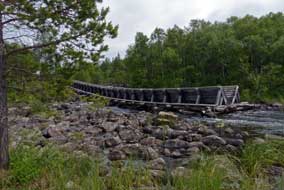 of the flume looking down its sloping length
towards Nellimjärvi way down below emphasised not only its 304m length but also
the 16m of height loss between the 2 lakes which the flume was constructed to
negotiate for log-floating (Photo
21 - Nellim log-floating flume) (see right). The story goes that in its operational day, it was a
sporting challenge for timber men to 'ride' the flume standing on a log! It was
hard to imagine the speed at which logs would travel down the flume in the
descending water-flow, and the noise of logs crashing against the sides of the
trough. The natural down-flow of the rapids at the far side was quite
insignificant at this time of year when the lake's water level was at its
lowest. of the flume looking down its sloping length
towards Nellimjärvi way down below emphasised not only its 304m length but also
the 16m of height loss between the 2 lakes which the flume was constructed to
negotiate for log-floating (Photo
21 - Nellim log-floating flume) (see right). The story goes that in its operational day, it was a
sporting challenge for timber men to 'ride' the flume standing on a log! It was
hard to imagine the speed at which logs would travel down the flume in the
descending water-flow, and the noise of logs crashing against the sides of the
trough. The natural down-flow of the rapids at the far side was quite
insignificant at this time of year when the lake's water level was at its
lowest.
Back down the track to the bottom end of the
flume, we scrambled over boulders to view the flume's exit chute where logs
would have spilled into Lake Nellimjärvi (see left) (Photo
22 - Exit of log-flume); peaceful now, the air here would once have been
filled with
the noise of rushing water and the crashing of
logs ejected from the flume's bottom end into the lower lake, to be gathered here
into controlled batches for onward floating into Lake Inarijärvi. We returned by
the same route as the outward walk through the forest, with the swarming midges
keeping us moving, to reach the remains of wartime fortifications near to the Rautaportti
Iron Gates. Here we followed a side-path up to the brim of the narrow rocky
canyon overlooking the inlet of Nellimjärvi where in mid 1944 the Germans and
Russians dug in on the cliffs had faced one another across the gorge; the cliffs
of the Iron Gates were some 30m in height, and the canyon narrowed to the
inlet's inner point where the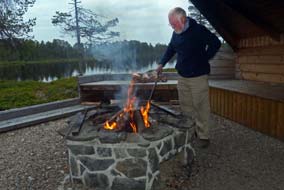 isthmus formed the low stretch of land separating Nellimjärvi
from Inarijärvi crossed by the Arctic Ocean Road. isthmus formed the low stretch of land separating Nellimjärvi
from Inarijärvi crossed by the Arctic Ocean Road.
Evening
camp-fire at Nellim: back
at camp that evening, we lit a camp-fire in the
hearth at the hotel's lakeside kota shelter to barbecue sausages (Photo
23 - Nellim camp-fire) (see right), and sat for supper looking
out across Lake Maajärvi, snugly sheltered from the chill wind by the warmth of
a roaring fire. Today had been a satisfying day: a good walk on a well-marked
trail with plenty of interesting wild flora, a chance to examine at close
quarters the superbly reconstructed log-flume giving a clearer indication of the
difficulties in transporting timber by floating in such wild wilderness terrain,
and a greater understanding of the relationships between Finns and Germans in
the northern front war with USSR as the Germans retreated from Lapland. We had
also greeted the Pasvik River on its southern side of the Russian border, having
camped on its banks last year in the Øvre Pasvik Valley. We also now had a clearer understanding of the history of Finland's brief
occupation of Arctic Petsamo, and the tragic displacement and resettlement
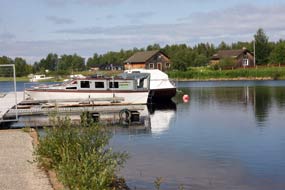 of
the Skolt Sámi. It would see strange tomorrow returning to 'civilisation' at Ivalo after 4 days out here in the wilderness lands at Nellim. of
the Skolt Sámi. It would see strange tomorrow returning to 'civilisation' at Ivalo after 4 days out here in the wilderness lands at Nellim.
Return to Ivalo: although the sun was not actually
shining the following morning, the sky was brighter and the air warmer; St
Tryphon must have been smiling on us. We had a long day ahead, but before
leaving Nellim we drove down to the harbour. Inarijärvi looked serene under a
blue sky with the reflection of boats in the lake backed by the farms of Nellim
across the water, perhaps the site of the original Nellim farm from which the
village had taken its name (Photo
24 - Nellim harbour) (see left). We finally departed Nellim and hit the
dirt road, having learnt so much about this wilderness outpost during our 4 day
stay, with its boom years of logging and the building of the Arctic Ocean Road;
now with the loss of Petsamo, it was literally an end-of-road backwater with
little left but tourism to sustain the small community's livelihood.
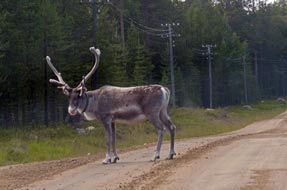 The return drive along the 35 kms of dirt road
seemed less long than the outward journey, but the road surface felt rougher
and there was more traffic than at weekends (Photo
25- Nellim~Ivalo road) and the occasional reindeer (see right). We steadily bumped along, finally
to reach the tarmac at Keväjärvi, the third village in addition to Sevettijärvi
and Nellim where the Skolt Sámi, displaced from Finnish Petsamo by the Soviets,
had been resettled in 1948. Just beyond the village we turned off onto a side
road leading to the shore of Inarijärvi at Veskoniemi, in order to visit 2
bird-watching towers (lintutorni) detailed in the
Lapland Crossbill Guide. 4 kms along we reached the first tower overlooking Iso-Miellöjärvi and the surrounding aapa-marshes of the Ivalojoki river
flood-plain. 300m through the pine forest from the parking area, The return drive along the 35 kms of dirt road
seemed less long than the outward journey, but the road surface felt rougher
and there was more traffic than at weekends (Photo
25- Nellim~Ivalo road) and the occasional reindeer (see right). We steadily bumped along, finally
to reach the tarmac at Keväjärvi, the third village in addition to Sevettijärvi
and Nellim where the Skolt Sámi, displaced from Finnish Petsamo by the Soviets,
had been resettled in 1948. Just beyond the village we turned off onto a side
road leading to the shore of Inarijärvi at Veskoniemi, in order to visit 2
bird-watching towers (lintutorni) detailed in the
Lapland Crossbill Guide. 4 kms along we reached the first tower overlooking Iso-Miellöjärvi and the surrounding aapa-marshes of the Ivalojoki river
flood-plain. 300m through the pine forest from the parking area,
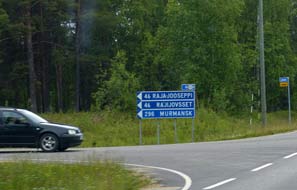 the tower stood
on the lake shore; from its top the only bird life we could see was a pair of
cranes grazing on the marshes and a few duck on the lake. The second tower in a
further 5 kms was reached along a 1.2 km path and overlooked the Ivalojoki delta marshes where it flowed into Inarijärvi lake. As we approached the tower
we were surprised to hear noisy human voices from a group of German boy-scouts
camped at the remote tower's foot; their noise was enough to scare away
any bird life in the vicinity, and from the tower we could see nothing but a
family of Velvet Scoters diving and bobbing up like corks. Leaving the scouts to
their camp, we returned to Ivalo, passing the turning to Murmansk 300 kms from
Ivalo (see left). the tower stood
on the lake shore; from its top the only bird life we could see was a pair of
cranes grazing on the marshes and a few duck on the lake. The second tower in a
further 5 kms was reached along a 1.2 km path and overlooked the Ivalojoki delta marshes where it flowed into Inarijärvi lake. As we approached the tower
we were surprised to hear noisy human voices from a group of German boy-scouts
camped at the remote tower's foot; their noise was enough to scare away
any bird life in the vicinity, and from the tower we could see nothing but a
family of Velvet Scoters diving and bobbing up like corks. Leaving the scouts to
their camp, we returned to Ivalo, passing the turning to Murmansk 300 kms from
Ivalo (see left).
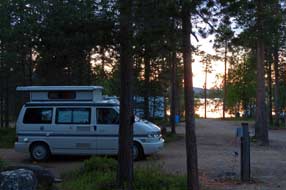 An inhospitable non-welcome at Ukonjärvi
Camping: having re-stocked with provisions from the S-Market, diesel from the filling station and cash from
the ATM, it was time finally to leave Ivalo, and crossing the wide Ivalojoki we
headed north on Route 4/E75 to turn off in 9kms to find tonight's campsite, Ukonjärvi Camping. At reception we were treated to an utterly unsmiling and
inhospitable non-welcome from the owner, his surly wife and their unfriendly
Alsatian guard-dog; we had earlier received an equally ill-gracious response to
our telephone enquiry. How such ill-mannered and inhospitable campsite owners
remain in business can only be explained by the endless streams of tourists
flocking along the Lapland highway; after a long day we were too weary to do
other than to respond with indifferent contempt, and settled in under the pine
trees overlooking Lake Inarijärvi. An inhospitable non-welcome at Ukonjärvi
Camping: having re-stocked with provisions from the S-Market, diesel from the filling station and cash from
the ATM, it was time finally to leave Ivalo, and crossing the wide Ivalojoki we
headed north on Route 4/E75 to turn off in 9kms to find tonight's campsite, Ukonjärvi Camping. At reception we were treated to an utterly unsmiling and
inhospitable non-welcome from the owner, his surly wife and their unfriendly
Alsatian guard-dog; we had earlier received an equally ill-gracious response to
our telephone enquiry. How such ill-mannered and inhospitable campsite owners
remain in business can only be explained by the endless streams of tourists
flocking along the Lapland highway; after a long day we were too weary to do
other than to respond with indifferent contempt, and settled in under the pine
trees overlooking Lake Inarijärvi.
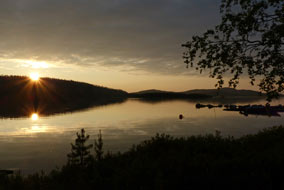 A spectacular sunset: the Midnight
Sun period had officially now ended here at Inarijärvi, but after supper that
evening the sky cleared and the sun, still brightly shining, declined towards
the forested hills along the sky-line above the lake, leaving the forest still
bright (Photo
26 - Lake sun over forest camp) (see above right). At 10-30pm we walked down to the lake shore
for semi-Midnight Sun photos along with a Swiss lady we had earlier chatted with
in the campsite kitchen; Antje was familiar with Lapland and the tragic history
of the Skolts, and clearly had similar values to ourselves. The sun disappeared
behind the hill leaving a glowing luminescent salmon pink sky (Photo
27 - Salmon pink glowing sky) (see left), and we stood
taking post-sunset photos, hoping the declining sun would not fully set but
might re-appear from behind the line of hills as it A spectacular sunset: the Midnight
Sun period had officially now ended here at Inarijärvi, but after supper that
evening the sky cleared and the sun, still brightly shining, declined towards
the forested hills along the sky-line above the lake, leaving the forest still
bright (Photo
26 - Lake sun over forest camp) (see above right). At 10-30pm we walked down to the lake shore
for semi-Midnight Sun photos along with a Swiss lady we had earlier chatted with
in the campsite kitchen; Antje was familiar with Lapland and the tragic history
of the Skolts, and clearly had similar values to ourselves. The sun disappeared
behind the hill leaving a glowing luminescent salmon pink sky (Photo
27 - Salmon pink glowing sky) (see left), and we stood
taking post-sunset photos, hoping the declining sun would not fully set but
might re-appear from behind the line of hills as it
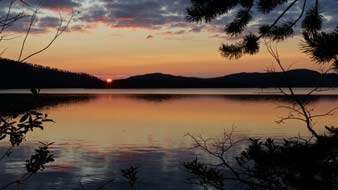 traversed along the horizon
towards the north. Antje, the Swiss lady who had been standing in the forest,
came running over to say the sun was just visible further around; we hurried
over just in time to catch the final glowing red semi-orb of the setting sun as it
traversed a gap on the horizon between hills, seeming to move at an incredibly fast rate (Photo
28 - Setting sun traversing horizon) (see right). Within
moments, the setting sun had crossed the sky-line gap and disappeared for the
final time behind the right hand hill. By the time we turned at in 1-00am, the sun, although not visible to
us, had clearly completed its brief period of 'night' and was beginning to rise
prior to its early dawn, and as a result the sky was visibly lightening, turning
from deep glow to paler pink. traversed along the horizon
towards the north. Antje, the Swiss lady who had been standing in the forest,
came running over to say the sun was just visible further around; we hurried
over just in time to catch the final glowing red semi-orb of the setting sun as it
traversed a gap on the horizon between hills, seeming to move at an incredibly fast rate (Photo
28 - Setting sun traversing horizon) (see right). Within
moments, the setting sun had crossed the sky-line gap and disappeared for the
final time behind the right hand hill. By the time we turned at in 1-00am, the sun, although not visible to
us, had clearly completed its brief period of 'night' and was beginning to rise
prior to its early dawn, and as a result the sky was visibly lightening, turning
from deep glow to paler pink.
North to Inari and a walk to Pielpajärvi Wilderness Church:
the following morning, the full extent of the wretchedly neglected state of Ukonjärvi
Camping's facilities become fully evident: they were not only just
old-fashioned, but grubby and uncleaned, the hand-drier was broken,
paper-towel-holder left unfilled, there was water all over the floor of the WC
cubicles, and every
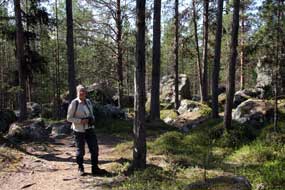 hook in the showers was broken. And for all of this neglect
and their ill-mannered lack of hospitality, they were charging one of the most
expensive prices encountered across Finland. Other travellers should take note
and boycott the place.
We returned to Route 4/E75, and on a lovely sunny morning, with Inarijärvi
looking idyllic reflecting the clear blue sky, we headed north for the 30 kms
alongside the lake to Inari. Reaching the outskirts of the town, we pulled into
Uruniemi Camping to reserve our lakeside hook in the showers was broken. And for all of this neglect
and their ill-mannered lack of hospitality, they were charging one of the most
expensive prices encountered across Finland. Other travellers should take note
and boycott the place.
We returned to Route 4/E75, and on a lovely sunny morning, with Inarijärvi
looking idyllic reflecting the clear blue sky, we headed north for the 30 kms
alongside the lake to Inari. Reaching the outskirts of the town, we pulled into
Uruniemi Camping to reserve our lakeside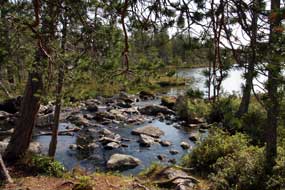 terrace pitch, the only flat spot in
the place. After our experience in 2012, we were resigned to the same unwelcoming
response from the surly owner here. The lake-side terrace was free; we booked
in and reserved our pitch. Down through Inari village, beyond the excellent SIIDA
Sámi Cultural Museum visited in 2012 (see our 2012 log),
we turned off along the lane to the parking area for today's walk out to
Pielpajärvi Erämaakirkko (Wilderness Church). terrace pitch, the only flat spot in
the place. After our experience in 2012, we were resigned to the same unwelcoming
response from the surly owner here. The lake-side terrace was free; we booked
in and reserved our pitch. Down through Inari village, beyond the excellent SIIDA
Sámi Cultural Museum visited in 2012 (see our 2012 log),
we turned off along the lane to the parking area for today's walk out to
Pielpajärvi Erämaakirkko (Wilderness Church).
With the sky thankfully clear and sun shining warm and bright, we set off for
the 9km round trip. Long before the modern village of Inari was built on Route 4
in the early 20th century, the meadows around Pielpajärvi formed the original
encampment settlement (sajos) for the Inari Sámi, where the nomadic
reindeer-herding families had once over-wintered in their kota huts after following
their herds over the high fells during summer. An older wooden church had served
them since their conversion to Christianity in the mid-17th century, and the
current church was built in 1760. When the winter grazing meadows were abandoned and
the Sámi moved to Inari, the wooden church was saved from dereliction and
restored to its former glory in the 1970s. Due to its remoteness, the church had
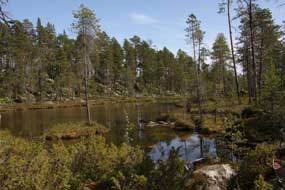 even escaped the destructive attention of the retreating Germans in 1944. even escaped the destructive attention of the retreating Germans in 1944.
The path was well-marked
(Click here for
map of Pielpajärvi path) but now badly eroded into
a wide track-way by the 1000s of walkers who annually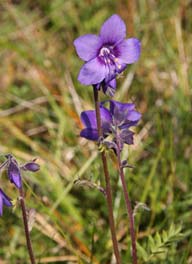 tread this route out to
the Wilderness Church (Photo
29 - Forest path to Wilderness Church) (see above left). It began through Lapland virgin pine and
spruce forests, with large glacial boulders littering the forest floor, their
tops covered with thick layers of moss where grazing reindeer could not reach.
We had these peaceful forests to ourselves and on such a sunny day this was a
truly delightful walk with reindeer fencing lining the path. Scattered among the
forest trees were long dead pines (Kelo pines in Finnish) still standing,
with their skeletal upper branches and trunks bare of bark revealing the spiral
twist of the wood. After some 2 kms winding through the forest, the path reached
the first of a series of small lakes where the waters of Pielpajärvi lakes
drain down towards Inarijärvi. The sun sparkled on the trickling waters of the
stream connecting the lakes (Photo 30 - Pielpajärvi lakes)
(see above right). The path crossed marshy ground on a short section of board-walk and
continued along the shore of the small Puntsijärvi lake (see left) (Photo
31- Puntsijärvi lake), the path surface uneven with
tree-roots and boulders making for slow progress as we tried to avoid further
erosion by keeping to the main path and avoiding smoother side paths. Reaching Pikku Pielpajärvi lake, the path passed over a narrow spit of forested land that
separated Iso-(Big) from Pikku (Little) tread this route out to
the Wilderness Church (Photo
29 - Forest path to Wilderness Church) (see above left). It began through Lapland virgin pine and
spruce forests, with large glacial boulders littering the forest floor, their
tops covered with thick layers of moss where grazing reindeer could not reach.
We had these peaceful forests to ourselves and on such a sunny day this was a
truly delightful walk with reindeer fencing lining the path. Scattered among the
forest trees were long dead pines (Kelo pines in Finnish) still standing,
with their skeletal upper branches and trunks bare of bark revealing the spiral
twist of the wood. After some 2 kms winding through the forest, the path reached
the first of a series of small lakes where the waters of Pielpajärvi lakes
drain down towards Inarijärvi. The sun sparkled on the trickling waters of the
stream connecting the lakes (Photo 30 - Pielpajärvi lakes)
(see above right). The path crossed marshy ground on a short section of board-walk and
continued along the shore of the small Puntsijärvi lake (see left) (Photo
31- Puntsijärvi lake), the path surface uneven with
tree-roots and boulders making for slow progress as we tried to avoid further
erosion by keeping to the main path and avoiding smoother side paths. Reaching Pikku Pielpajärvi lake, the path passed over a narrow spit of forested land that
separated Iso-(Big) from Pikku (Little)
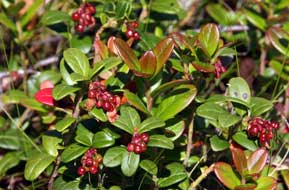 Pielpajärvi lakes, and crossed the
stream connecting the 2 lakes on a plank-bridge. Over a high shoulder of land,
the path descended to an inlet of Iso-Pielpajärvi where Butterworts and Spotted
Orchids grew in the marshy lake-side sphagnum. The path continued ahead,
undulating over the higher forested spit of land separating the 2 lakes, leading
to the Pielpajärvi meadows, once the winter grazing for the Sämis' reindeer.
Here the floral gem of the walk awaited us, the tall and elegant blue-mauve
flowers of Lapland Jacob's Ladder
(Polemonium acutiflorum) (see right) (Photo
32 - Lapland Jacob's Ladder), still flourishing among the
meadow's long grass.
Across
the far side of the meadow, we reached the ancient Wilderness Church (Photo
33 - Pielpajärvi Wilderness Church) (see below right) and here in the birch grove we found the first ripening Lingonberries seen this year (see left). We
opened up the church shutters to let in more light for photos inside the
beautiful wooden church (Photo
34 - Wilderness Church interior), then sat on the porch steps to eat our
lunch sandwiches before beginning the return walk. Pielpajärvi lakes, and crossed the
stream connecting the 2 lakes on a plank-bridge. Over a high shoulder of land,
the path descended to an inlet of Iso-Pielpajärvi where Butterworts and Spotted
Orchids grew in the marshy lake-side sphagnum. The path continued ahead,
undulating over the higher forested spit of land separating the 2 lakes, leading
to the Pielpajärvi meadows, once the winter grazing for the Sämis' reindeer.
Here the floral gem of the walk awaited us, the tall and elegant blue-mauve
flowers of Lapland Jacob's Ladder
(Polemonium acutiflorum) (see right) (Photo
32 - Lapland Jacob's Ladder), still flourishing among the
meadow's long grass.
Across
the far side of the meadow, we reached the ancient Wilderness Church (Photo
33 - Pielpajärvi Wilderness Church) (see below right) and here in the birch grove we found the first ripening Lingonberries seen this year (see left). We
opened up the church shutters to let in more light for photos inside the
beautiful wooden church (Photo
34 - Wilderness Church interior), then sat on the porch steps to eat our
lunch sandwiches before beginning the return walk.
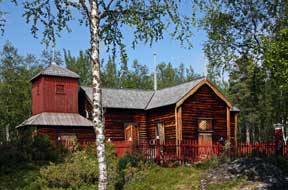 We
set off at a purposeful pace, back across the meadow, along the bouldery path
alongside the lakes, and as we entered the pine forest, another Siberian Jay
called for our attention: 'Look at me', he seemed to say as these beautiful
birds seem to do, flitting from bough to bough among the pines and just giving
us time to raise cameras for a photo (see below left). Completing the
final section of the walk, we drove back to Inari and settled into our lake-side
pitch at Uruniemi Camping. The weather had We
set off at a purposeful pace, back across the meadow, along the bouldery path
alongside the lakes, and as we entered the pine forest, another Siberian Jay
called for our attention: 'Look at me', he seemed to say as these beautiful
birds seem to do, flitting from bough to bough among the pines and just giving
us time to raise cameras for a photo (see below left). Completing the
final section of the walk, we drove back to Inari and settled into our lake-side
pitch at Uruniemi Camping. The weather had
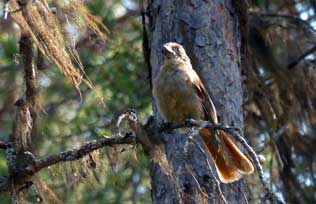 remained
warm and sunny all day, the first decent summer's day of 2015 so far, enabling
us to walk without sweaters, and now back at camp with the sun casting a
long glittering tail across Inarijärvi, we sat out enjoying the early evening
sunshine. The barbecue was lit and, despite the swarming blackfly, we were able
to sit for supper with the warm sun streaming in through the camper's open
sliding door, quite unprecedented this trip. remained
warm and sunny all day, the first decent summer's day of 2015 so far, enabling
us to walk without sweaters, and now back at camp with the sun casting a
long glittering tail across Inarijärvi, we sat out enjoying the early evening
sunshine. The barbecue was lit and, despite the swarming blackfly, we were able
to sit for supper with the warm sun streaming in through the camper's open
sliding door, quite unprecedented this trip.
Another spectacular sunset across Inarijärvi:
the sky remained clear with not a cloud in sight, and we followed the downward
course of the sun as it declined across the lake. By 10-30pm, it was approaching
the low, hilly skyline on the far side of the lake, its golden tail still
trailing across the width of Inarijärvi (Photo
35 - Evening sun across Inarijärvi). At 11-00pm, with midges swarming round
our heads, we walked down to the lake jetty for photos as the setting sun
declined to the distant sky-line
(Photo
36 - Setting sun). Through our long distance lens, we could
actually see trees along the hilly horizon silhouetted against the sun's ruddy
orb as it touched the sky-line and visibly traversed as it sank lower (see
right). By 11-20pm
the sun's now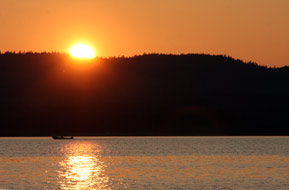 semi-orb finally set below the wooded horizon on the far side of
the lake. We had hoped that with its traversing course it might reappear at a
dip in the sky-line hills as last night, but this evening its downward course
caused it to set fully. All during this spectacular display, we had taken a
series of
photos of the almost, not quite Midnight Sun's golden decline,
including semi-silhouette portraits against the setting sun. Now in a semi-dusky
light with the sun fully set, we returned to George and turned in at 11-45pm
(see left). semi-orb finally set below the wooded horizon on the far side of
the lake. We had hoped that with its traversing course it might reappear at a
dip in the sky-line hills as last night, but this evening its downward course
caused it to set fully. All during this spectacular display, we had taken a
series of
photos of the almost, not quite Midnight Sun's golden decline,
including semi-silhouette portraits against the setting sun. Now in a semi-dusky
light with the sun fully set, we returned to George and turned in at 11-45pm
(see left).
Out into the wilderness of Lemmenjoki National Park: what a dramatic
change in the weather the following morning: yesterday's brief summer was gone,
and we woke to solidly overcast cloud cover replacing the bright sun of last
evening, with the lake now totally obscured by dense mist and the air chill and
moist. Having re-filled George with fresh water we drove down into Inari to shop
for 3 day's supplies at the village's K-Market, and set off south-westerly on
Route 955 heading for Lemmenjoki National Park. This road stretches its lonely
way over some 200 kms of empty, uninhabited wilderness all the way across
Lapland to Kittilä. On such a gloomily overcast morning, the bleak, marshy
forested wilderness looked even more forbiddingly grim than usual, the cloud
level so low as to be touching distant fells. In such conditions, this was a
thoroughly depressing landscape (see below right). The road was at least
tarmaced but virtually deserted and we passed more reindeer than vehicles. After
30 kms
of this monotonously grey wilderness, we reached the Sámi reindeer herding
settlement of Menesjärvi, and turned off here for Njurkulahti and the Lemmenjoki
National Park. This 10 kms of side-road had at least been tarmaced since we were
last here in 2012, improving the access to remote Lemmenjoki. The
narrow, single-track lane wound an undulating course through forested terrain,
finally reaching the tiny Sámi hamlet of Menesjärvi, and turned off here for Njurkulahti and the Lemmenjoki
National Park. This 10 kms of side-road had at least been tarmaced since we were
last here in 2012, improving the access to remote Lemmenjoki. The
narrow, single-track lane wound an undulating course through forested terrain,
finally reaching the tiny Sámi hamlet of
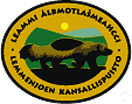 Njurkulahti. The camping area at
Lemmenjoki Café-Camping was little more than a small patch of rough ground with
limited flat space overlooking
the river (Photo
37 - Lemmenjoki Camping); the young lady from the local
Sámi family that owned the site was welcoming and spoke good English, and we
eventually found a flattish spot and settled in. We had expected this to be a
peaceful little campsite in this isolated wilderness location, but the parking
area turned out to be full of cars belonging to those attending a gold-panning
competition in the hills; this and the abysmally chill and gloomy weather
which showed little prospect of change, together with the swarming blackflies
that filled the camper, and a rowdy group camping nearby, were all real
deterrents. We should have to make the best of it, in order to walk the
Lemmenjoki Nature Trail tomorrow. At least the sky did clear later in the
evening to produce a spectacular sunset along the river
(Photo
38 - Lemmenjoki sunset). Njurkulahti. The camping area at
Lemmenjoki Café-Camping was little more than a small patch of rough ground with
limited flat space overlooking
the river (Photo
37 - Lemmenjoki Camping); the young lady from the local
Sámi family that owned the site was welcoming and spoke good English, and we
eventually found a flattish spot and settled in. We had expected this to be a
peaceful little campsite in this isolated wilderness location, but the parking
area turned out to be full of cars belonging to those attending a gold-panning
competition in the hills; this and the abysmally chill and gloomy weather
which showed little prospect of change, together with the swarming blackflies
that filled the camper, and a rowdy group camping nearby, were all real
deterrents. We should have to make the best of it, in order to walk the
Lemmenjoki Nature Trail tomorrow. At least the sky did clear later in the
evening to produce a spectacular sunset along the river
(Photo
38 - Lemmenjoki sunset).
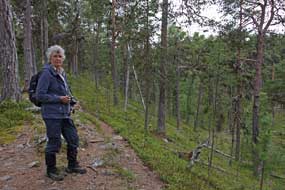 Lemmenjoki Nature Trail: the following morning, the sky was again
heavily overcast and each time we opened the camper's sliding door blackfly
swarmed in. We reserved the one and only flat spot vacated by another camper,
and drove around to the parking area for today's walk of the 4 km Lemmenjoki Nature
Trail (Click here for
map of Lemmenjoki Nature Trail). The path began from the parking area,
passing through virgin forest of pine and spruce, with a number of dead and
fallen trees. The route followed the line of the local reindeer-herding Lemmenjoki Nature Trail: the following morning, the sky was again
heavily overcast and each time we opened the camper's sliding door blackfly
swarmed in. We reserved the one and only flat spot vacated by another camper,
and drove around to the parking area for today's walk of the 4 km Lemmenjoki Nature
Trail (Click here for
map of Lemmenjoki Nature Trail). The path began from the parking area,
passing through virgin forest of pine and spruce, with a number of dead and
fallen trees. The route followed the line of the local reindeer-herding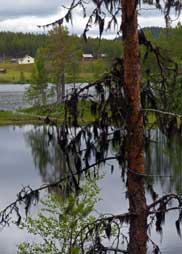 cooperative which grazes some 9,000 animals in the northern Lemmenjoki forests.
On the far side of the fence the forest was commercially maintained with more
widely spaced younger trees, and the lichen and ground cover grazed by reindeer. As the path sloped down towards an inlet of the river, Paul discovered that his
camera was producing bizarrely over-exposed results and giving an error message.
Cleaning the lens contacts had no effect, and the camera still showed
the same fault; 8 further weeks of the trip with compromised camera did not bear
thinking about.
cooperative which grazes some 9,000 animals in the northern Lemmenjoki forests.
On the far side of the fence the forest was commercially maintained with more
widely spaced younger trees, and the lichen and ground cover grazed by reindeer. As the path sloped down towards an inlet of the river, Paul discovered that his
camera was producing bizarrely over-exposed results and giving an error message.
Cleaning the lens contacts had no effect, and the camera still showed
the same fault; 8 further weeks of the trip with compromised camera did not bear
thinking about.
Across the hill top where the dead pines supported dense patches
of beard lichen (see right), the path descended towards the wide river with views across
towards an ancient Sámi farmstead on the far bank (Photo
39 - Sámi farmstead). A short distance further, a
steep slope led up onto the leading edge of a glacial esker ridge with the path
continuing along the esker's crest. This was a classic esker with the steep
sides of the narrow ridge dropping some 40m on each side, looking down onto the
tops of pines growing on the side-slopes
(Photo
40 - Esker ridge) (see above
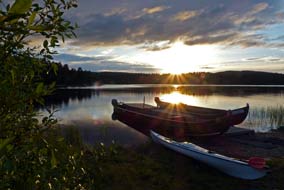 left). We continued along the esker's narrow
crest through this ancient forest, the slope on the northern side flattening
onto a plateau and on the southern side falling steeply down into a moist
seepage valley with its dense vegetation cover. The path dropped down to a gap
in the ridge, where the Lemmenjoki long distance route continued ahead; our path
descended into a valley, undulating through ancient virgin forest past a group
of kettle holes formed in the glacial moraine by residual melting blocks of ice as the
glacier had retreated. A short distance further, the path crossed the dried up
water-course down which Spring melt-waters drain down into the seepage valley.
The rocky banks of the gulley hosted a wealth of Twin Flowers in flourishing
banks
(Photo
41 - Twin Flowers). The final section of the trail crossed a flat
heath-land of ancient, undisturbed pines, some 100s of years old, some of the
dead ones still standing and, having lost their bark, now showing the twisted
wood grain. left). We continued along the esker's narrow
crest through this ancient forest, the slope on the northern side flattening
onto a plateau and on the southern side falling steeply down into a moist
seepage valley with its dense vegetation cover. The path dropped down to a gap
in the ridge, where the Lemmenjoki long distance route continued ahead; our path
descended into a valley, undulating through ancient virgin forest past a group
of kettle holes formed in the glacial moraine by residual melting blocks of ice as the
glacier had retreated. A short distance further, the path crossed the dried up
water-course down which Spring melt-waters drain down into the seepage valley.
The rocky banks of the gulley hosted a wealth of Twin Flowers in flourishing
banks
(Photo
41 - Twin Flowers). The final section of the trail crossed a flat
heath-land of ancient, undisturbed pines, some 100s of years old, some of the
dead ones still standing and, having lost their bark, now showing the twisted
wood grain.
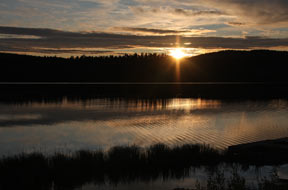 Back to camp at Njurkulahti, we re-pitched in our
reserved spot at the rough camping area, and that evening, after an overcast
day, the sky at last cleared late evening to give another flaring sunset across the
river (see right) (Photo
42 - Flaring sunset). Back to camp at Njurkulahti, we re-pitched in our
reserved spot at the rough camping area, and that evening, after an overcast
day, the sky at last cleared late evening to give another flaring sunset across the
river (see right) (Photo
42 - Flaring sunset).
Foul weather and days in camp at Jokitörmä Camping at Kaamanen: today's
forecast rain began early; it was indeed a foul day, with grey misty cloud
obscuring the distant fells. We postponed a decision on today's venture hoping
the weather might improve, but the soaking wet rain increased during the morning
ruling out our planned 36 km drive deeper into the Lemmenjoki National Park to
explore the conserved Sallivaara reindeer round-up pens. Yesterday's walk had
been enjoyable, but this year the poor weather had made Lemmenjoki something of
an anticlimax. At 12-30pm, with the rain now pouring and little hope of change,
we gave up, packed the camper and drove back along the Njurkulahti lane to
return to Inari. In the misty, driving rain, the featureless forests and bogs
looked more dreary than ever. Reaching Inari, we pulled into the Sámi Parliament
to use their wi-fi to check the forecast: frustratingly the overcast conditions
would continue throughout the week. Having re-stocked with provisions at the
Inari supermarket, we headed north on Route 4/E75 passing a couple of bedraggled
reindeer who had ventured from the forests; the rain was still pouring and Inarijärvi scarcely visible in the dark, misty rain cloud.
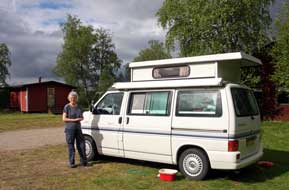 Reaching Kaamanen, we were greeted at Jokitörmä
Camping with the same smiling welcome as always from the gentle couple who have
kept the hostel/campsite for many years. Down at the riverside camping area,
despite the gravelly ground the rain of the past 48 hours had caused
water-logging, but we found a dry spot next to the kitchen hut. Pulling out the
awning for shelter, we settled in and stowed our shopping. The pouring rain
continued, the air was chill and, despite being July we needed the heater on to
combat the cold draughts. Whether it was the gloomy weather, George's interior
lights seemed dim, and on checking the leisure battery level, the voltage was
down;
despite being on mains, the charger was not
working. It was likely to be a blown fuse but the weather was simply too wet to
check that tonight; a job for the morning. The rain eased but the air was still
chill and laden with soaking mist; on such a wretched evening, a warming supper
cooked in the campsite kitchen to conserve our gas supply cheered us. 2015
summer was a write-off! Reaching Kaamanen, we were greeted at Jokitörmä
Camping with the same smiling welcome as always from the gentle couple who have
kept the hostel/campsite for many years. Down at the riverside camping area,
despite the gravelly ground the rain of the past 48 hours had caused
water-logging, but we found a dry spot next to the kitchen hut. Pulling out the
awning for shelter, we settled in and stowed our shopping. The pouring rain
continued, the air was chill and, despite being July we needed the heater on to
combat the cold draughts. Whether it was the gloomy weather, George's interior
lights seemed dim, and on checking the leisure battery level, the voltage was
down;
despite being on mains, the charger was not
working. It was likely to be a blown fuse but the weather was simply too wet to
check that tonight; a job for the morning. The rain eased but the air was still
chill and laden with soaking mist; on such a wretched evening, a warming supper
cooked in the campsite kitchen to conserve our gas supply cheered us. 2015
summer was a write-off!
The following morning, the sky was still overcast
but much brighter, and the wind had swung round from the north making it feel so
much warmer. The green 30 amp blade fuse on the leisure battery circuit was
caked with grime, and a clean up of the contacts did the trick: the battery
gauge immediately swung over to indicate a healthily full charge with the
charger now functioning. The weather
continued to improve during the day and a weak sun managed to shine making it a
really pleasant day in camp here at Jokitörmä (Photo
43 - Jokitörmä Camping at Kaamanen). The air
was now so warm that, in contrast with the last few days of northerly wind,
today we sat in shirt-sleeves (see above left); here within the Arctic, wind direction makes such
a difference. And that evening we cooked a celebratory Jokitörmä supper of
reindeer and lingonberry stew. But today's
 fine weather was not to last;
on checking the forecast using the campsite wi-fi up at reception, tomorrow was
back to being a thoroughly wet day again; what a non-summer! Rain began
overnight, and the following day misty rain was falling steadily, worsening during
the morning; with the wind back in the north and light poor, it was another
thoroughly cold and wet day, definite camp day weather. Facilities at Jokitörmä
Camping were good, and most importantly in such miserably chill weather, the
showers were comfortably heated, strange as that seems to say in July! fine weather was not to last;
on checking the forecast using the campsite wi-fi up at reception, tomorrow was
back to being a thoroughly wet day again; what a non-summer! Rain began
overnight, and the following day misty rain was falling steadily, worsening during
the morning; with the wind back in the north and light poor, it was another
thoroughly cold and wet day, definite camp day weather. Facilities at Jokitörmä
Camping were good, and most importantly in such miserably chill weather, the
showers were comfortably heated, strange as that seems to say in July!
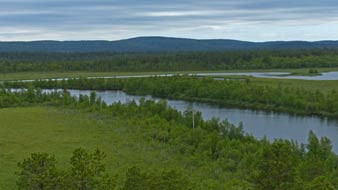 Bird-watching on the Kettujoki and Kaamasjoki
rivers: we departed the following morning, back into Inari to re-stock
with provisions with the weather still overcast. Having completed our
shopping, we turned off 4 kms north of Inari onto Route 9553, a single-track
tarmaced lane which led eventually to Angeli, a remote Sámi village out in the
Lemmenjoki fells close to the Norwegian border. Our intention was to find a
bird-watching site where the road crosses the Kettujoki river bridge just before
the Kettukoski rapids. This is some of the earliest ice-free stretches of water
and in the early part of the year attracts many migrating birds; whether we
should see anything this late in the season however was doubtful. The lane
passed Rintula and ran alongside the river under the forested Ristivaara fells
to reach the bridge. As expected there was little bird-life save for families of
Goldeneye ducks with mother and chicks, and an Arctic Tern swooping low over the
river and diving for fish. Back to the main Route 4/E75, we turned off again
just before Kaamanen onto Route 9710, another single-track lane, to find the Kaamasjoki
river delta bird-watching tower. 3 kms along we passed the Reindeer Research
Station and just beyond a sharp bend, reached the wooden tower set on a
forested hillock. This was the tallest bird-watching tower experienced so far
with a fearful climb up to its observation platform. Again the Kaamasjoki river
delta attracts many species of aquatic birds when the ice melts in May, but in
July there was nothing to be seen over the marshes and branches of the river
delta (see above left and right). We had learnt of both of today's bird-watching
sites from the ever valuable Crossbill Guide to
Lapland. Bird-watching on the Kettujoki and Kaamasjoki
rivers: we departed the following morning, back into Inari to re-stock
with provisions with the weather still overcast. Having completed our
shopping, we turned off 4 kms north of Inari onto Route 9553, a single-track
tarmaced lane which led eventually to Angeli, a remote Sámi village out in the
Lemmenjoki fells close to the Norwegian border. Our intention was to find a
bird-watching site where the road crosses the Kettujoki river bridge just before
the Kettukoski rapids. This is some of the earliest ice-free stretches of water
and in the early part of the year attracts many migrating birds; whether we
should see anything this late in the season however was doubtful. The lane
passed Rintula and ran alongside the river under the forested Ristivaara fells
to reach the bridge. As expected there was little bird-life save for families of
Goldeneye ducks with mother and chicks, and an Arctic Tern swooping low over the
river and diving for fish. Back to the main Route 4/E75, we turned off again
just before Kaamanen onto Route 9710, another single-track lane, to find the Kaamasjoki
river delta bird-watching tower. 3 kms along we passed the Reindeer Research
Station and just beyond a sharp bend, reached the wooden tower set on a
forested hillock. This was the tallest bird-watching tower experienced so far
with a fearful climb up to its observation platform. Again the Kaamasjoki river
delta attracts many species of aquatic birds when the ice melts in May, but in
July there was nothing to be seen over the marshes and branches of the river
delta (see above left and right). We had learnt of both of today's bird-watching
sites from the ever valuable Crossbill Guide to
Lapland.
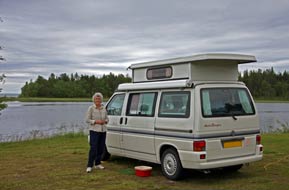
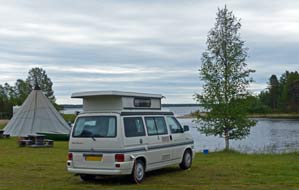 Hietajoki
Camping on SW shore of Lake Inarijärvi:
at Kaamanen we turned off onto Route 971 for the 33 kms drive along to
tonight's campsite, Hietajoki Camping, set on the SW shore of Lake Inarijärvi.
We had passed this site several times in the past and last year had noted its
coordinates. The sky was still lightly overcast but clearing from the north.
Hietajoki was a basic site with huts mainly used by lake fishermen, and we were
greeted by the elderly lady owner who spoke little English. We managed to find a
reasonably flat pitch with the camping area sloping steeply down to the lake
shore. That evening as we barbecued supper, fishing boats arrived and departed
from the campsite mooring, and we sat looking out across to Inarijärvi's distant
shore through a gap between the lake islands; it was a truly peaceful spot (see
left and right). The following morning we woke to clear sky and bright, warming
sunshine with a breeze from across the lake keeping the midges away; for the
first time in weeks, we were able to sit out for breakfast
looking out across the lake (Photo
44 - Hietajoki Camping). Hietajoki
Camping on SW shore of Lake Inarijärvi:
at Kaamanen we turned off onto Route 971 for the 33 kms drive along to
tonight's campsite, Hietajoki Camping, set on the SW shore of Lake Inarijärvi.
We had passed this site several times in the past and last year had noted its
coordinates. The sky was still lightly overcast but clearing from the north.
Hietajoki was a basic site with huts mainly used by lake fishermen, and we were
greeted by the elderly lady owner who spoke little English. We managed to find a
reasonably flat pitch with the camping area sloping steeply down to the lake
shore. That evening as we barbecued supper, fishing boats arrived and departed
from the campsite mooring, and we sat looking out across to Inarijärvi's distant
shore through a gap between the lake islands; it was a truly peaceful spot (see
left and right). The following morning we woke to clear sky and bright, warming
sunshine with a breeze from across the lake keeping the midges away; for the
first time in weeks, we were able to sit out for breakfast
looking out across the lake (Photo
44 - Hietajoki Camping).
Route 971 to Sevettijärvi and options for camping: it was a further 50 kms northward along
the lonely Route 971 to the Skolt re-settlement village of Sevettijärvi, and we
enjoyed a steady drive on a bright morning through sandy, forested heath-lands along the western shore of
Inarijärvi with occasional views of the lake (Photo
45 - Route 971 to Sevettijärvi ). On the southern approaches to the
village, we passed Nili Tuvat, a well-established and attractive-looking hut and fishing site which
this year advertised camping, and which had been recommended to us by Antje, the
Swiss girl we had met at Ukonjärvi Camping; this was another possible camping
option for us in addition to the 2 sites in the village,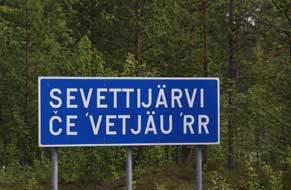 Peuralammen Camping and Sevetinharju Camping. For now we continued ahead into
the scattered village of Sevettijärvi (see right). We had also been alerted by
Antje to dissentions within the small community caused by a new baari
(tavern/café) recently started up at Peuralammen Camping in competition with the
long-established baari-cum-shop/café in the village centre which also
served as a social centre for the small community. On the way through the
village, we paused to investigate Sevetinharju Camping whose leaflet we had
picked up at SIIDA, but the place appeared semi-derelict. As we drove into the
village centre, the sign to the long-established baari was now covered
up; further back another sign was lying on the roadside verge. Beyond the Skolt
Museum and church, we turned along the gravel road behind the grave-yard signed
to Peuralammen Camping, but this looked equally unappealing with no obvious
space to camp; a couple of the huts had cars outside and a small marquee seemed
to be the rival baari (tavern) which a sign said was now open
0900~2400. There was no one about and we turned back into the village and paused
at the church.
Peuralammen Camping and Sevetinharju Camping. For now we continued ahead into
the scattered village of Sevettijärvi (see right). We had also been alerted by
Antje to dissentions within the small community caused by a new baari
(tavern/café) recently started up at Peuralammen Camping in competition with the
long-established baari-cum-shop/café in the village centre which also
served as a social centre for the small community. On the way through the
village, we paused to investigate Sevetinharju Camping whose leaflet we had
picked up at SIIDA, but the place appeared semi-derelict. As we drove into the
village centre, the sign to the long-established baari was now covered
up; further back another sign was lying on the roadside verge. Beyond the Skolt
Museum and church, we turned along the gravel road behind the grave-yard signed
to Peuralammen Camping, but this looked equally unappealing with no obvious
space to camp; a couple of the huts had cars outside and a small marquee seemed
to be the rival baari (tavern) which a sign said was now open
0900~2400. There was no one about and we turned back into the village and paused
at the church.
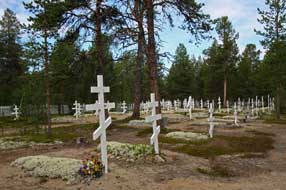 Sevettijärvi
village, Orthodox church and graveyard: with mosquitoes and blackfly
swarming around our heads, we walked along to re-visit the Orthodox graveyard.
There were several new graves all covered with lichen as is the local practice.
One of the graves had the plaque: Antii Gauriloff, born 10 June 1940 Petsamo,
died 22 June 2015 Ivalo; at the time of the evacuation from Petsamo, he would
have been a child of 4 years of age. The original families of Skolt refugees
were now almost all dead, and their resettlement village of Sevettijärvi now
seemed a community riven by dissention, doubly sad given the Skolts' tragic
history. We again took photos of the graves with their lichen covering and
Orthodox crosses
(see left)
(Photo
46 - Orthodox graves at Sevettijärvi), and beat a hasty retreat from the
mosquitoes. Around at the village baari-cum-shop/café, the building was
all locked up and deserted, and further along the reindeer meat shop was also
clearly closed with a derelict truck outside. Despite the glitzy tourist
brochures on the racks at SIIDA, the reality was that, although Sevettijärvi had
200 residents, as a
community it seemed moribund, robbed of its social centre by commercial greed. Sevettijärvi
village, Orthodox church and graveyard: with mosquitoes and blackfly
swarming around our heads, we walked along to re-visit the Orthodox graveyard.
There were several new graves all covered with lichen as is the local practice.
One of the graves had the plaque: Antii Gauriloff, born 10 June 1940 Petsamo,
died 22 June 2015 Ivalo; at the time of the evacuation from Petsamo, he would
have been a child of 4 years of age. The original families of Skolt refugees
were now almost all dead, and their resettlement village of Sevettijärvi now
seemed a community riven by dissention, doubly sad given the Skolts' tragic
history. We again took photos of the graves with their lichen covering and
Orthodox crosses
(see left)
(Photo
46 - Orthodox graves at Sevettijärvi), and beat a hasty retreat from the
mosquitoes. Around at the village baari-cum-shop/café, the building was
all locked up and deserted, and further along the reindeer meat shop was also
clearly closed with a derelict truck outside. Despite the glitzy tourist
brochures on the racks at SIIDA, the reality was that, although Sevettijärvi had
200 residents, as a
community it seemed moribund, robbed of its social centre by commercial greed.
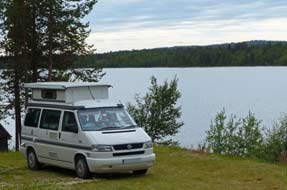 Nili Tuvat Camping
at Sevettijärvi,
a pleasant location but expensive: we returned along to Nili Tuvat with its more
appealing lake-side setting. The tarmaced driveway led around past the
well-established huts to a flat and attractive grassy terrace overlooking the
lake and pitched here, picking up power from a nearby hut. The place was in a
lovely location and had a well-cared for air, in total Nili Tuvat Camping
at Sevettijärvi,
a pleasant location but expensive: we returned along to Nili Tuvat with its more
appealing lake-side setting. The tarmaced driveway led around past the
well-established huts to a flat and attractive grassy terrace overlooking the
lake and pitched here, picking up power from a nearby hut. The place was in a
lovely location and had a well-cared for air, in total
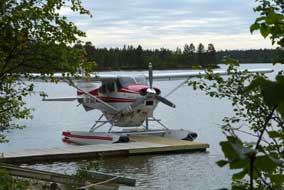 contrast with the
semi-derelict places in the village. Reception was
at an almost affluent-looking
house, and an older woman speaking no English
booked us in. The price however was an
extortionate €28/night with no room for negotiation or discount; that was
totally unprecedented, more than we had paid in the whole of Finland, even at
the capital Helsinki. Wanting to stay in Sevettijärvi, we acquiesced but insisted she opened up the locked showers and
kitchen for us before we settled in at the grassy terrace overlooking
Lake Nilijärvi
(Photo
47 - Nili Tuvat Camping) (see right). The whole environment of the place
seemed rather alien to Lapland's normal wilderness terrain; the beautifully
landscaped grounds even had sweetly scented clover among the lawns and it almost
seemed an expensive holiday location for the 4WD nouveaux-riches here for the
fishing. As we were settling in, a float-plane had landed on the lake and was
now moored at the jetty below us (see left). In spectacular fashion, the plane took off again
from the lake ferrying a group of tourists, and re-landed later in the afternoon; perhaps
the plane was based here on
Lake Nilijärvi at Nili Tuvat to fly
tourist fishermen up here from Inari
(Photo
48 - Lake Nilijärvi float-plane). The float-plane landing and
taking off from the lake provided an entertainment during our lakeside stay at
Nili Tuvat (see below left), and that evening we were treated to another flaring sunset
across the lake (see below right). contrast with the
semi-derelict places in the village. Reception was
at an almost affluent-looking
house, and an older woman speaking no English
booked us in. The price however was an
extortionate €28/night with no room for negotiation or discount; that was
totally unprecedented, more than we had paid in the whole of Finland, even at
the capital Helsinki. Wanting to stay in Sevettijärvi, we acquiesced but insisted she opened up the locked showers and
kitchen for us before we settled in at the grassy terrace overlooking
Lake Nilijärvi
(Photo
47 - Nili Tuvat Camping) (see right). The whole environment of the place
seemed rather alien to Lapland's normal wilderness terrain; the beautifully
landscaped grounds even had sweetly scented clover among the lawns and it almost
seemed an expensive holiday location for the 4WD nouveaux-riches here for the
fishing. As we were settling in, a float-plane had landed on the lake and was
now moored at the jetty below us (see left). In spectacular fashion, the plane took off again
from the lake ferrying a group of tourists, and re-landed later in the afternoon; perhaps
the plane was based here on
Lake Nilijärvi at Nili Tuvat to fly
tourist fishermen up here from Inari
(Photo
48 - Lake Nilijärvi float-plane). The float-plane landing and
taking off from the lake provided an entertainment during our lakeside stay at
Nili Tuvat (see below left), and that evening we were treated to another flaring sunset
across the lake (see below right).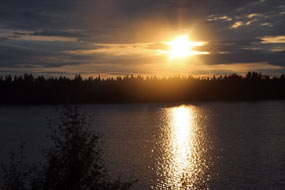
The Norwegian border at Näätämö : the following morning was gloomy
and overcast again with light rain. Today was the beginning of August, when
it might have been expected for the mosquitoes and blackfly to be coming to an
end. Far from it; in 'summer'
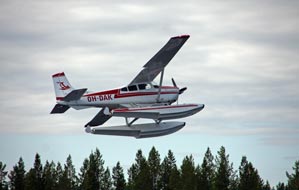 2015 they were worse than ever this morning,
swarming into the camper each time the door was opened. When it
came to getting showers, there was only one open, and inevitably a queue; enough was enough
when we were paying €28! When asked to open the other showers, the surly woman's
only response was an indifferent shrug. Nili Tuvat's lakeside setting was
lovely, but the owner's churlish and unhelpful manner, the limited facilities
and greed-driven unreasonably high price makes Nili Tuvat a place to be avoided.
By the time we set off, there was wet, misty drizzle and zero visibility. We
drove north towards Näätämö in such miserable conditions, seeing nothing of the
magnificent fell-scape and boulder-fields alongside northern Lake
Inarijärvi. And the weather simply got worse the further north we drove, with
pouring rain and gloomy mist obscuring the distant fells. Reaching Näätämö, we pulled into the K-Market for our final food shopping at Finnish
prices before entering more expensive Norway. Even the Näätämö reindeer which
usually grazed the parking area were absent today in such foul weather
conditions. In pouring rain and low mist, we crossed the border reindeer grid
into Norway; and on the Norwegian side of the border, the weather was no better. 2015 they were worse than ever this morning,
swarming into the camper each time the door was opened. When it
came to getting showers, there was only one open, and inevitably a queue; enough was enough
when we were paying €28! When asked to open the other showers, the surly woman's
only response was an indifferent shrug. Nili Tuvat's lakeside setting was
lovely, but the owner's churlish and unhelpful manner, the limited facilities
and greed-driven unreasonably high price makes Nili Tuvat a place to be avoided.
By the time we set off, there was wet, misty drizzle and zero visibility. We
drove north towards Näätämö in such miserable conditions, seeing nothing of the
magnificent fell-scape and boulder-fields alongside northern Lake
Inarijärvi. And the weather simply got worse the further north we drove, with
pouring rain and gloomy mist obscuring the distant fells. Reaching Näätämö, we pulled into the K-Market for our final food shopping at Finnish
prices before entering more expensive Norway. Even the Näätämö reindeer which
usually grazed the parking area were absent today in such foul weather
conditions. In pouring rain and low mist, we crossed the border reindeer grid
into Norway; and on the Norwegian side of the border, the weather was no better.
We shall now travel around to Kirkenes in furthest NE
Norway. Having spent time at Nellim at the southern side of the Paatsjoki/Pasvik
River, we shall return to the Øvre Pasvik
Valley on the northern side, to revisit that remote and curiously anomalous
southward projecting salient of Norwegian territory wedged between the Russian
Oblast of Murmansk on the Petsamo peninsula and the remote NE area of Finland.
Around Varanger Fjord, we shall re-visit Vestre Jakobselv and Vadsø, before
turning north at Tana Bru to spend a few days at the Barents Sea coast fishing
port of Berlevåg, one of our favourite places in Scandinavia. Re-crossing into
Finland at Utsjoki, we shall travel along the Tana/Teno River to Karigasniemi,
cut across northern Norway via Kautokeino before visiting the furthest NW
outpost of Finland at Kilpisjärvi. Our homeward journey starts there, southwards
to Enontekiö. But all of that is for our next edition, to be
published shortly.
Next edition
to be published quite soon
|
Sheila and Paul |
Published: 22 January 2016 |
|
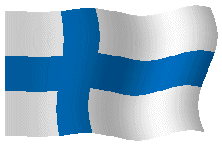
 CAMPING
IN FINLAND 2015 - Finnish Lapland - Urho Kekkonen National Park, Nellim and Russian border, Ivalo
and Inari, Lemmenjoki National Park, Kaamanen, Lake Inarijärvi and Sevettijärvi,
Norwegian Border at Näätamö:
CAMPING
IN FINLAND 2015 - Finnish Lapland - Urho Kekkonen National Park, Nellim and Russian border, Ivalo
and Inari, Lemmenjoki National Park, Kaamanen, Lake Inarijärvi and Sevettijärvi,
Norwegian Border at Näätamö: and bird-watching tower.
Today's broken cloud brought sunny spells but also risk of downpours, so in spite
of the now warm weather, we kitted up with cagoules and midge helmets. The
route out to the bird-watching tower (Lintutorni in Finnish) was
via a curving 450m long board-walk across the marshes, and from the information
panel we learnt a new word - flarks - meaning depressions of standing water
across the marsh. The mires experienced so far had been semi-solid areas of
continuous sphagnum, sometimes vegetation-covered; here at Ilmakkiaapa, the
protected marshland, restored to its undrained state had open areas of deep,
standing water which in Springtime floods might overflow the board-walk. These
flooded depressions in the mire, dotted with Bogbeans and Rannoch Rush, are
called flarks (see left). Gingerly we crossed the flooded flarks at the start of
the board-walk, and continued across the broader sphagnum-covered area of the
mire (
and bird-watching tower.
Today's broken cloud brought sunny spells but also risk of downpours, so in spite
of the now warm weather, we kitted up with cagoules and midge helmets. The
route out to the bird-watching tower (Lintutorni in Finnish) was
via a curving 450m long board-walk across the marshes, and from the information
panel we learnt a new word - flarks - meaning depressions of standing water
across the marsh. The mires experienced so far had been semi-solid areas of
continuous sphagnum, sometimes vegetation-covered; here at Ilmakkiaapa, the
protected marshland, restored to its undrained state had open areas of deep,
standing water which in Springtime floods might overflow the board-walk. These
flooded depressions in the mire, dotted with Bogbeans and Rannoch Rush, are
called flarks (see left). Gingerly we crossed the flooded flarks at the start of
the board-walk, and continued across the broader sphagnum-covered area of the
mire ( The
board-walk was lined with Bog Rosemary the flowers now past, and the drier
carpets of sphagnum supported huge patches of insectivorous Sundew, normally
only found in tiny isolated plants but here growing in the largest colony of
Sundew ever seen (see left), with Cranberry flowers nearby. The board-walk curved around to
a wetter area of sphagnum where frilly-flowered Bogbeans grew up through the
moss. Further on, Cloudberry grew alongside the boards, the fruit just beginning
to ripen, with masses of Cranberry flowers, growing in huge clumps across the
sphagnum (
The
board-walk was lined with Bog Rosemary the flowers now past, and the drier
carpets of sphagnum supported huge patches of insectivorous Sundew, normally
only found in tiny isolated plants but here growing in the largest colony of
Sundew ever seen (see left), with Cranberry flowers nearby. The board-walk curved around to
a wetter area of sphagnum where frilly-flowered Bogbeans grew up through the
moss. Further on, Cloudberry grew alongside the boards, the fruit just beginning
to ripen, with masses of Cranberry flowers, growing in huge clumps across the
sphagnum ( Vuotson Maja Inn/Camping: following
the Kitinen River which flowed through a linked series of lakes, the Route 4
highway took us northwards; reaching the Sámi reindeer-herding village of Vuotso, we spotted a sign for the Vuotson Maja B&B/Camping, and pulled in
to investigate. There had been an inn on the E75 Lapland road here at Vuotso
since 1949 (see left); the friendly owners had newly taken over and were in process of
renovating the accommodation. Although the sign promoted camping, this would
not be fully ready until next year; we were however most welcome to camp on what
was still a rough patch of ground behind the inn and use the facilities inside
the house. Since there was no other campsite between here and Ivalo (other than
the grubby place at
Vuotson Maja Inn/Camping: following
the Kitinen River which flowed through a linked series of lakes, the Route 4
highway took us northwards; reaching the Sámi reindeer-herding village of Vuotso, we spotted a sign for the Vuotson Maja B&B/Camping, and pulled in
to investigate. There had been an inn on the E75 Lapland road here at Vuotso
since 1949 (see left); the friendly owners had newly taken over and were in process of
renovating the accommodation. Although the sign promoted camping, this would
not be fully ready until next year; we were however most welcome to camp on what
was still a rough patch of ground behind the inn and use the facilities inside
the house. Since there was no other campsite between here and Ivalo (other than
the grubby place at Tankavaara gold-mining museum), we gladly accepted their
hospitality and settled in, with the sultry weather attracting swarms of midges
which filled the camper. Although there was no kitchen, the Vuotson Maja's
WC/showers were a homely luxury, and wi-fi was available in the Inn's reception.
Once the camping area is properly laid out, this would make a welcoming and
worthwhile Lapland stop-over on the E75 between Sodankylä and Ivalo, and
convenient for the Urho Kekkonen National Park where we planned to walk
tomorrow.
Tankavaara gold-mining museum), we gladly accepted their
hospitality and settled in, with the sultry weather attracting swarms of midges
which filled the camper. Although there was no kitchen, the Vuotson Maja's
WC/showers were a homely luxury, and wi-fi was available in the Inn's reception.
Once the camping area is properly laid out, this would make a welcoming and
worthwhile Lapland stop-over on the E75 between Sodankylä and Ivalo, and
convenient for the Urho Kekkonen National Park where we planned to walk
tomorrow. were still in
bud. We soon began to encounter the distinctive Cow Wheat which we had seen for
the first time on this walk in 2012 and which for us will always be associated with the Urho
Kekkonen National Park (
were still in
bud. We soon began to encounter the distinctive Cow Wheat which we had seen for
the first time on this walk in 2012 and which for us will always be associated with the Urho
Kekkonen National Park ( remains of a German WW2 gun emplacement to sit for our lunch
sandwiches, looking out across the tree tops below to the distant fells. As we
resumed our climb, alongside the path we found patches of Alpine Bearberry with
green unripe fruits growing among the Crowberry and Bilberry (see right), and the distinctive
strands of Twin Flower leaves with tiny flower buds (
remains of a German WW2 gun emplacement to sit for our lunch
sandwiches, looking out across the tree tops below to the distant fells. As we
resumed our climb, alongside the path we found patches of Alpine Bearberry with
green unripe fruits growing among the Crowberry and Bilberry (see right), and the distinctive
strands of Twin Flower leaves with tiny flower buds ( Crossing
the summit boulder-field, the path began the descent into birch trees again,
passing lovely patches of Chickweed Wintergreen and Dwarf Cornel
flowers
sheltering around the base of birches (see left). The path dropped down through
the birches to reach the spruce level again, and as the gradient
Crossing
the summit boulder-field, the path began the descent into birch trees again,
passing lovely patches of Chickweed Wintergreen and Dwarf Cornel
flowers
sheltering around the base of birches (see left). The path dropped down through
the birches to reach the spruce level again, and as the gradient
 slackened here
the long board-walk began. This wove its way through increasingly dense conifer
woods, and as we advanced we were surprised to meet a fully-antlered reindeer
coming up the board-walk; equally startled, he scampered off into the forest
giving us a wide berth (see right). The forest opened up as the board-walk
crossed open sedge mire in the water gathering area of the upper Hopiaoja stream.
The board-walk continued through a drier forested area to reach a laavu shelter,
and followed the stream through denser woodland. Re-crossing the Hopiaoja steam
on board-walk along a marshy valley, we passed more Cloudberry and some Spotted
Orchids. The path led back through pine forest to the Visitor Centre where
another reindeer grazed the track side verges, this time indifferent to our
presence (
slackened here
the long board-walk began. This wove its way through increasingly dense conifer
woods, and as we advanced we were surprised to meet a fully-antlered reindeer
coming up the board-walk; equally startled, he scampered off into the forest
giving us a wide berth (see right). The forest opened up as the board-walk
crossed open sedge mire in the water gathering area of the upper Hopiaoja stream.
The board-walk continued through a drier forested area to reach a laavu shelter,
and followed the stream through denser woodland. Re-crossing the Hopiaoja steam
on board-walk along a marshy valley, we passed more Cloudberry and some Spotted
Orchids. The path led back through pine forest to the Visitor Centre where
another reindeer grazed the track side verges, this time indifferent to our
presence ( Inarijärvi. Approaching Ivalo, we reached tonight's campsite, Ivalo River
Camping, set by a filling station right alongside the busy highway. The reception
staff were friendly and welcoming, but when it came to finding a viable space to
camp, the place's inadequacies became evident. The riverside camping area across
the road was overwhelmed by traffic noise, and we eventually settled on a
limited grassy area by the huts. The welcome was pleasant and price cheap but
you get what you pay for: utterly basic facilities and limited camping space,
and traffic noise from the nearby main road. It would serve for one night, and
our supper of elk meat balls from Kylmänen cooked in a creamy lingonberry sauce
cheered the evening. Tonight was one of only four occasions this year when we
might experience the Midnight Sun; late evening, the sun re-emerged from cloud-cover to shine above the Ivalojoki river, but we were too weary for late
photographs and turned in.
Inarijärvi. Approaching Ivalo, we reached tonight's campsite, Ivalo River
Camping, set by a filling station right alongside the busy highway. The reception
staff were friendly and welcoming, but when it came to finding a viable space to
camp, the place's inadequacies became evident. The riverside camping area across
the road was overwhelmed by traffic noise, and we eventually settled on a
limited grassy area by the huts. The welcome was pleasant and price cheap but
you get what you pay for: utterly basic facilities and limited camping space,
and traffic noise from the nearby main road. It would serve for one night, and
our supper of elk meat balls from Kylmänen cooked in a creamy lingonberry sauce
cheered the evening. Tonight was one of only four occasions this year when we
might experience the Midnight Sun; late evening, the sun re-emerged from cloud-cover to shine above the Ivalojoki river, but we were too weary for late
photographs and turned in. This scarcely populated area around the NE
shore of Inarijärvi was originally settled by Inari Sámi reindeer-herders in the
1870s. One of the farms was named Nellim which gave its name to the scattered
farming settlement around Paatsjoki, the river which flows from Lake Inarijärvi
at its NE corner and marks the current border between Finland, Russia and Norway;
the river is
known in Norwegian as the Pasvik. Finns began moving into this area during
the 1920~30s with the development of intensive logging industry. The 1920 Treaty
of Tartu between the newly independent Finland and Lenin's USSR had originally
defined the border between the two countries. Through this treaty, Finland
had acquired the whole of the Petsamo region from Lake Inarijärvi
north-eastwards along the banks of the Paatsjoki/Pasvik River right through to
the port of Liinahamari on the Pechenga fjord-inlet of the Barents Sea. This
opening to the White Sea, together with extensive logging forests and the
Petsamo region's mineral wealth created enormous economic opportunities for
Finland. To open up this remote region and exploit its timber and mineral
resources, a major road construction was planned all the way
across Lapland from Rovaniemi, along the
This scarcely populated area around the NE
shore of Inarijärvi was originally settled by Inari Sámi reindeer-herders in the
1870s. One of the farms was named Nellim which gave its name to the scattered
farming settlement around Paatsjoki, the river which flows from Lake Inarijärvi
at its NE corner and marks the current border between Finland, Russia and Norway;
the river is
known in Norwegian as the Pasvik. Finns began moving into this area during
the 1920~30s with the development of intensive logging industry. The 1920 Treaty
of Tartu between the newly independent Finland and Lenin's USSR had originally
defined the border between the two countries. Through this treaty, Finland
had acquired the whole of the Petsamo region from Lake Inarijärvi
north-eastwards along the banks of the Paatsjoki/Pasvik River right through to
the port of Liinahamari on the Pechenga fjord-inlet of the Barents Sea. This
opening to the White Sea, together with extensive logging forests and the
Petsamo region's mineral wealth created enormous economic opportunities for
Finland. To open up this remote region and exploit its timber and mineral
resources, a major road construction was planned all the way
across Lapland from Rovaniemi, along the eastern shore of Inarijärvi, through
the farming hamlet of Nellim, and along the eastern bank of the Paatsjoki/Pasvik
River, connecting right through the Petsamo region to Liinahamari port on the
Barents Sea coast. Work began in 1916, and delayed by wars, the Arctic Ocean
Road (Jäämerentie) as it was called was completed in 1931. Road
construction was entirely by manual labour, providing employment for gangs of
men working plots of 100 length:
eastern shore of Inarijärvi, through
the farming hamlet of Nellim, and along the eastern bank of the Paatsjoki/Pasvik
River, connecting right through the Petsamo region to Liinahamari port on the
Barents Sea coast. Work began in 1916, and delayed by wars, the Arctic Ocean
Road (Jäämerentie) as it was called was completed in 1931. Road
construction was entirely by manual labour, providing employment for gangs of
men working plots of 100 length:
 numbers of not only workers but travellers to the
northern region, including an inn at what is now the border-post at Virtaninemi.
In addition to logging, the Road also opened up the Petsamo
region for exploitation of its mineral wealth: the mining town at Nikel (called
Kolosjoki by the Finns) was established in the 1930s with a rail link for mined
nickel ore to the port of Liinahamari. With the Russian invasion of Petsamo in
1939 and subsequent Continuation War brought to an end by the 1944 Treaty of
Moscow, all of this came to an end. Ever open to seizing opportunities, Stalin
forcibly annexed the entire Petsamo salient for its logging and mineral wealth,
including the Road from Nellim all the way to Liinahamari on the Barents Sea and
the mines and smelters at Nikel:
numbers of not only workers but travellers to the
northern region, including an inn at what is now the border-post at Virtaninemi.
In addition to logging, the Road also opened up the Petsamo
region for exploitation of its mineral wealth: the mining town at Nikel (called
Kolosjoki by the Finns) was established in the 1930s with a rail link for mined
nickel ore to the port of Liinahamari. With the Russian invasion of Petsamo in
1939 and subsequent Continuation War brought to an end by the 1944 Treaty of
Moscow, all of this came to an end. Ever open to seizing opportunities, Stalin
forcibly annexed the entire Petsamo salient for its logging and mineral wealth,
including the Road from Nellim all the way to Liinahamari on the Barents Sea and
the mines and smelters at Nikel:
 border with Russia, still retains its 3 cultures of the Inari-Sámi
indigenous settlers, the descendents of the 1920s Finnish settlers, and the 35
families of Skolt Sámi resettled here in 1948. Nowadays the wilderness tourist
industry has brought some economic revival along with residual farming and
reindeer-herding, but Nellim today has very much a forgotten and end-of-the-road
air.
border with Russia, still retains its 3 cultures of the Inari-Sámi
indigenous settlers, the descendents of the 1920s Finnish settlers, and the 35
families of Skolt Sámi resettled here in 1948. Nowadays the wilderness tourist
industry has brought some economic revival along with residual farming and
reindeer-herding, but Nellim today has very much a forgotten and end-of-the-road
air. Camping at Nellim Wilderness Hotel:
we had earlier received an email response confirming we could camp here,
and saying they were planning a camping area, but no more than that. At reception
we were greeted hospitably but it was as if, with camping being new, the staff
were unsure how to deal with our request. Facilities were limited to the hotel's
WC/showers and wi-fi, but there were no other cooking facilities except the
lakeside camp-fire hut. After some debate, we eventually agreed a daily rate of
€15 plus a negotiated amount for use of the showers, but what would happen when
Camping at Nellim Wilderness Hotel:
we had earlier received an email response confirming we could camp here,
and saying they were planning a camping area, but no more than that. At reception
we were greeted hospitably but it was as if, with camping being new, the staff
were unsure how to deal with our request. Facilities were limited to the hotel's
WC/showers and wi-fi, but there were no other cooking facilities except the
lakeside camp-fire hut. After some debate, we eventually agreed a daily rate of
€15 plus a negotiated amount for use of the showers, but what would happen when we came to settle up remained to be seen. The newly laid-out camping area was
nothing more than a fenced area of loose, sandy gravel with power supplies
along the side, stark and unappealing like a semi-derelict building site with
the debris of its recent construction littering the sandy surface. Having this
summer laid out this dreary patch of sandy dereliction that passed for a
campsite, it seemed that the hotel was relying on next winter's weight of snow
to consolidate the sand into something usable. In the meantime we settled in to
make the best of a poor lot if we were to camp at Nellim for our 4 days stay.
However basic, limited and grubby, at least there was somewhere to camp (see
left).
we came to settle up remained to be seen. The newly laid-out camping area was
nothing more than a fenced area of loose, sandy gravel with power supplies
along the side, stark and unappealing like a semi-derelict building site with
the debris of its recent construction littering the sandy surface. Having this
summer laid out this dreary patch of sandy dereliction that passed for a
campsite, it seemed that the hotel was relying on next winter's weight of snow
to consolidate the sand into something usable. In the meantime we settled in to
make the best of a poor lot if we were to camp at Nellim for our 4 days stay.
However basic, limited and grubby, at least there was somewhere to camp (see
left). The prefabricated wooden dwellings along the
lane looked probably to be those built hastily after WW2 to accommodate the
Skolt Sámi families displaced from Petsamo. The church was 1km up a side lane
into the forest, a truly wilderness church built in 1987 from logs to resemble
the old Petsamo convent church, and dedicated to St Tryphon of Petsamo (
The prefabricated wooden dwellings along the
lane looked probably to be those built hastily after WW2 to accommodate the
Skolt Sámi families displaced from Petsamo. The church was 1km up a side lane
into the forest, a truly wilderness church built in 1987 from logs to resemble
the old Petsamo convent church, and dedicated to St Tryphon of Petsamo ( meaning Thank you. We walked over to the cemetery
alongside the church where the graves were covered with lichen as at Sevettijärvi
and marked with Orthodox crosses (
meaning Thank you. We walked over to the cemetery
alongside the church where the graves were covered with lichen as at Sevettijärvi
and marked with Orthodox crosses ( usual No entry without permit
warning signs (
usual No entry without permit
warning signs ( the border between
Norway and now Russian Petsamo with the mining town of Nikel. Just beyond the border-line but out of sight from us at the Paatsjoki bridge, a series of 3 Russian hydro-electric dams at Rajakoski,
Jäniskoski and Kaitakoski now control the water levels in Lake Inarijärvi.
Despite the poor light, we took our photos from the bridge looking northwards to
where the river crosses the border into Russian territory 3 kms downstream, with
the border-zone warning signs just visible on a river island and on the river
banks (see right) (
the border between
Norway and now Russian Petsamo with the mining town of Nikel. Just beyond the border-line but out of sight from us at the Paatsjoki bridge, a series of 3 Russian hydro-electric dams at Rajakoski,
Jäniskoski and Kaitakoski now control the water levels in Lake Inarijärvi.
Despite the poor light, we took our photos from the bridge looking northwards to
where the river crosses the border into Russian territory 3 kms downstream, with
the border-zone warning signs just visible on a river island and on the river
banks (see right) ( A
walk to the Nellim reconstructed log-flume past the Iron Gates:
the following morning was indeed gloomily overcast again; the best you could say
was that it was not actually raining. Nellim had been our final chance this year to
see the Midnight Sun, but the sun had not actually shone during our 4 days here in this
godforsaken wilderness! We drove 4 kms eastwards along the dirt road beyond Nellim village to the Paksuvuono parking area for the 8 kms round walk out to the
reconstructed log-flume which connected Lakes Nellimjärvi and Keskimöjärvi for
log-floating, recalling Nellim's glory days during the 1920~30s logging era. The
path began along a cart-track and as we moved forwards, we
spotted a large bird flitting among the branches of pine trees with a low
whistling call; Sheila managed to get close-up photos which showed it clearly as
a Siberian Jay (
A
walk to the Nellim reconstructed log-flume past the Iron Gates:
the following morning was indeed gloomily overcast again; the best you could say
was that it was not actually raining. Nellim had been our final chance this year to
see the Midnight Sun, but the sun had not actually shone during our 4 days here in this
godforsaken wilderness! We drove 4 kms eastwards along the dirt road beyond Nellim village to the Paksuvuono parking area for the 8 kms round walk out to the
reconstructed log-flume which connected Lakes Nellimjärvi and Keskimöjärvi for
log-floating, recalling Nellim's glory days during the 1920~30s logging era. The
path began along a cart-track and as we moved forwards, we
spotted a large bird flitting among the branches of pine trees with a low
whistling call; Sheila managed to get close-up photos which showed it clearly as
a Siberian Jay ( war in the
north. The Germans heavily fortified the Iron Gates cliffs, and in 1944 the
advancing Soviets built opposing fortified positions on the northern side of the
cliffs along Nellimjärvi. There was little active fighting here until the German
retreat when the Iron Gates defence line fought a holding action to delay the
Soviet advance and allow German troops to be withdrawn towards Ivalo.
war in the
north. The Germans heavily fortified the Iron Gates cliffs, and in 1944 the
advancing Soviets built opposing fortified positions on the northern side of the
cliffs along Nellimjärvi. There was little active fighting here until the German
retreat when the Iron Gates defence line fought a holding action to delay the
Soviet advance and allow German troops to be withdrawn towards Ivalo. This eventually led to a junction with a forest track-way and around another
small bay of Nellimjärvi close to where we expected to find the exit of the
log-flume. We could hear in the distance the sound of the natural rapids
descending from the higher Lake Keskimöjärvi that the log-flume had been
constructed to bypass for timber-floating. But with all the rough, forested
fell-land around the lake-side, it was difficult to make out where the line of
rapids and parallel
flume actually were, and where the flume's outlet into Nellimjärvi
might be. A sign pointed uphill to a Tulipaikka which translated as
Fire-place; we took this to mean the camp-fire laavu (lean-to shelter) shown
on the map, and assuming this to be towards the top of the flume, we followed
this upwards. As the forest cleared, there ahead was the enormous wooden structure of
the log-flume stretching down the length of the hill-side at a steep angle (
This eventually led to a junction with a forest track-way and around another
small bay of Nellimjärvi close to where we expected to find the exit of the
log-flume. We could hear in the distance the sound of the natural rapids
descending from the higher Lake Keskimöjärvi that the log-flume had been
constructed to bypass for timber-floating. But with all the rough, forested
fell-land around the lake-side, it was difficult to make out where the line of
rapids and parallel
flume actually were, and where the flume's outlet into Nellimjärvi
might be. A sign pointed uphill to a Tulipaikka which translated as
Fire-place; we took this to mean the camp-fire laavu (lean-to shelter) shown
on the map, and assuming this to be towards the top of the flume, we followed
this upwards. As the forest cleared, there ahead was the enormous wooden structure of
the log-flume stretching down the length of the hill-side at a steep angle ( the 16m drop in height between the 2 lakes. The camp-fire laavu was
positioned half-way down the flume, with a platform enabling a clear view into
the flume's now dry trough up and down its length. Clambering up onto the
platform for photos of the flume's structure, we then followed a track
up towards the higher end at Lake Keskimöjärvi. The path was lined with masses
of flourishing Twin Flowers (
the 16m drop in height between the 2 lakes. The camp-fire laavu was
positioned half-way down the flume, with a platform enabling a clear view into
the flume's now dry trough up and down its length. Clambering up onto the
platform for photos of the flume's structure, we then followed a track
up towards the higher end at Lake Keskimöjärvi. The path was lined with masses
of flourishing Twin Flowers ( of the flume looking down its sloping length
towards Nellimjärvi way down below emphasised not only its 304m length but also
the 16m of height loss between the 2 lakes which the flume was constructed to
negotiate for log-floating (
of the flume looking down its sloping length
towards Nellimjärvi way down below emphasised not only its 304m length but also
the 16m of height loss between the 2 lakes which the flume was constructed to
negotiate for log-floating ( isthmus formed the low stretch of land separating Nellimjärvi
from Inarijärvi crossed by the Arctic Ocean Road.
isthmus formed the low stretch of land separating Nellimjärvi
from Inarijärvi crossed by the Arctic Ocean Road. of
the Skolt Sámi. It would see strange tomorrow returning to 'civilisation' at Ivalo after 4 days out here in the wilderness lands at Nellim.
of
the Skolt Sámi. It would see strange tomorrow returning to 'civilisation' at Ivalo after 4 days out here in the wilderness lands at Nellim.  The return drive along the 35 kms of dirt road
seemed less long than the outward journey, but the road surface felt rougher
and there was more traffic than at weekends (
The return drive along the 35 kms of dirt road
seemed less long than the outward journey, but the road surface felt rougher
and there was more traffic than at weekends ( the tower stood
on the lake shore; from its top the only bird life we could see was a pair of
cranes grazing on the marshes and a few duck on the lake. The second tower in a
further 5 kms was reached along a 1.2 km path and overlooked the Ivalojoki delta marshes where it flowed into Inarijärvi lake. As we approached the tower
we were surprised to hear noisy human voices from a group of German boy-scouts
camped at the remote tower's foot; their noise was enough to scare away
any bird life in the vicinity, and from the tower we could see nothing but a
family of Velvet Scoters diving and bobbing up like corks. Leaving the scouts to
their camp, we returned to Ivalo, passing the turning to Murmansk 300 kms from
Ivalo (see left).
the tower stood
on the lake shore; from its top the only bird life we could see was a pair of
cranes grazing on the marshes and a few duck on the lake. The second tower in a
further 5 kms was reached along a 1.2 km path and overlooked the Ivalojoki delta marshes where it flowed into Inarijärvi lake. As we approached the tower
we were surprised to hear noisy human voices from a group of German boy-scouts
camped at the remote tower's foot; their noise was enough to scare away
any bird life in the vicinity, and from the tower we could see nothing but a
family of Velvet Scoters diving and bobbing up like corks. Leaving the scouts to
their camp, we returned to Ivalo, passing the turning to Murmansk 300 kms from
Ivalo (see left).  An inhospitable non-welcome at Ukonjärvi
Camping: having re-stocked with provisions from the S-Market, diesel from the filling station and cash from
the ATM, it was time finally to leave Ivalo, and crossing the wide Ivalojoki we
headed north on Route 4/E75 to turn off in 9kms to find tonight's campsite, Ukonjärvi Camping. At reception we were treated to an utterly unsmiling and
inhospitable non-welcome from the owner, his surly wife and their unfriendly
Alsatian guard-dog; we had earlier received an equally ill-gracious response to
our telephone enquiry. How such ill-mannered and inhospitable campsite owners
remain in business can only be explained by the endless streams of tourists
flocking along the Lapland highway; after a long day we were too weary to do
other than to respond with indifferent contempt, and settled in under the pine
trees overlooking Lake Inarijärvi.
An inhospitable non-welcome at Ukonjärvi
Camping: having re-stocked with provisions from the S-Market, diesel from the filling station and cash from
the ATM, it was time finally to leave Ivalo, and crossing the wide Ivalojoki we
headed north on Route 4/E75 to turn off in 9kms to find tonight's campsite, Ukonjärvi Camping. At reception we were treated to an utterly unsmiling and
inhospitable non-welcome from the owner, his surly wife and their unfriendly
Alsatian guard-dog; we had earlier received an equally ill-gracious response to
our telephone enquiry. How such ill-mannered and inhospitable campsite owners
remain in business can only be explained by the endless streams of tourists
flocking along the Lapland highway; after a long day we were too weary to do
other than to respond with indifferent contempt, and settled in under the pine
trees overlooking Lake Inarijärvi. A spectacular sunset: the Midnight
Sun period had officially now ended here at Inarijärvi, but after supper that
evening the sky cleared and the sun, still brightly shining, declined towards
the forested hills along the sky-line above the lake, leaving the forest still
bright (
A spectacular sunset: the Midnight
Sun period had officially now ended here at Inarijärvi, but after supper that
evening the sky cleared and the sun, still brightly shining, declined towards
the forested hills along the sky-line above the lake, leaving the forest still
bright ( traversed along the horizon
towards the north. Antje, the Swiss lady who had been standing in the forest,
came running over to say the sun was just visible further around; we hurried
over just in time to catch the final glowing red semi-orb of the setting sun as it
traversed a gap on the horizon between hills, seeming to move at an incredibly fast rate (
traversed along the horizon
towards the north. Antje, the Swiss lady who had been standing in the forest,
came running over to say the sun was just visible further around; we hurried
over just in time to catch the final glowing red semi-orb of the setting sun as it
traversed a gap on the horizon between hills, seeming to move at an incredibly fast rate ( hook in the showers was broken. And for all of this neglect
and their ill-mannered lack of hospitality, they were charging one of the most
expensive prices encountered across Finland. Other travellers should take note
and boycott the place.
We returned to Route 4/E75, and on a lovely sunny morning, with Inarijärvi
looking idyllic reflecting the clear blue sky, we headed north for the 30 kms
alongside the lake to Inari. Reaching the outskirts of the town, we pulled into
Uruniemi Camping to reserve our lakeside
hook in the showers was broken. And for all of this neglect
and their ill-mannered lack of hospitality, they were charging one of the most
expensive prices encountered across Finland. Other travellers should take note
and boycott the place.
We returned to Route 4/E75, and on a lovely sunny morning, with Inarijärvi
looking idyllic reflecting the clear blue sky, we headed north for the 30 kms
alongside the lake to Inari. Reaching the outskirts of the town, we pulled into
Uruniemi Camping to reserve our lakeside terrace pitch, the only flat spot in
the place. After our experience in 2012, we were resigned to the same unwelcoming
response from the surly owner here. The lake-side terrace was free; we booked
in and reserved our pitch. Down through Inari village, beyond the excellent SIIDA
Sámi Cultural Museum visited in 2012 (
terrace pitch, the only flat spot in
the place. After our experience in 2012, we were resigned to the same unwelcoming
response from the surly owner here. The lake-side terrace was free; we booked
in and reserved our pitch. Down through Inari village, beyond the excellent SIIDA
Sámi Cultural Museum visited in 2012 ( even escaped the destructive attention of the retreating Germans in 1944.
even escaped the destructive attention of the retreating Germans in 1944. tread this route out to
the Wilderness Church (
tread this route out to
the Wilderness Church ( Pielpajärvi lakes, and crossed the
stream connecting the 2 lakes on a plank-bridge. Over a high shoulder of land,
the path descended to an inlet of Iso-Pielpajärvi where Butterworts and Spotted
Orchids grew in the marshy lake-side sphagnum. The path continued ahead,
undulating over the higher forested spit of land separating the 2 lakes, leading
to the Pielpajärvi meadows, once the winter grazing for the Sämis' reindeer.
Here the floral gem of the walk awaited us, the tall and elegant blue-mauve
flowers of
Pielpajärvi lakes, and crossed the
stream connecting the 2 lakes on a plank-bridge. Over a high shoulder of land,
the path descended to an inlet of Iso-Pielpajärvi where Butterworts and Spotted
Orchids grew in the marshy lake-side sphagnum. The path continued ahead,
undulating over the higher forested spit of land separating the 2 lakes, leading
to the Pielpajärvi meadows, once the winter grazing for the Sämis' reindeer.
Here the floral gem of the walk awaited us, the tall and elegant blue-mauve
flowers of  We
set off at a purposeful pace, back across the meadow, along the bouldery path
alongside the lakes, and as we entered the pine forest, another Siberian Jay
called for our attention: 'Look at me', he seemed to say as these beautiful
birds seem to do, flitting from bough to bough among the pines and just giving
us time to raise cameras for a photo (see below left). Completing the
final section of the walk, we drove back to Inari and settled into our lake-side
pitch at Uruniemi Camping. The weather had
We
set off at a purposeful pace, back across the meadow, along the bouldery path
alongside the lakes, and as we entered the pine forest, another Siberian Jay
called for our attention: 'Look at me', he seemed to say as these beautiful
birds seem to do, flitting from bough to bough among the pines and just giving
us time to raise cameras for a photo (see below left). Completing the
final section of the walk, we drove back to Inari and settled into our lake-side
pitch at Uruniemi Camping. The weather had
 remained
warm and sunny all day, the first decent summer's day of 2015 so far, enabling
us to walk without sweaters, and now back at camp with the sun casting a
long glittering tail across Inarijärvi, we sat out enjoying the early evening
sunshine. The barbecue was lit and, despite the swarming blackfly, we were able
to sit for supper with the warm sun streaming in through the camper's open
sliding door, quite unprecedented this trip.
remained
warm and sunny all day, the first decent summer's day of 2015 so far, enabling
us to walk without sweaters, and now back at camp with the sun casting a
long glittering tail across Inarijärvi, we sat out enjoying the early evening
sunshine. The barbecue was lit and, despite the swarming blackfly, we were able
to sit for supper with the warm sun streaming in through the camper's open
sliding door, quite unprecedented this trip. semi-orb finally set below the wooded horizon on the far side of
the lake. We had hoped that with its traversing course it might reappear at a
dip in the sky-line hills as last night, but this evening its downward course
caused it to set fully. All during this spectacular display, we had taken a
series of
photos of the almost, not quite Midnight Sun's golden decline,
including semi-silhouette portraits against the setting sun. Now in a semi-dusky
light with the sun fully set, we returned to George and turned in at 11-45pm
(see left).
semi-orb finally set below the wooded horizon on the far side of
the lake. We had hoped that with its traversing course it might reappear at a
dip in the sky-line hills as last night, but this evening its downward course
caused it to set fully. All during this spectacular display, we had taken a
series of
photos of the almost, not quite Midnight Sun's golden decline,
including semi-silhouette portraits against the setting sun. Now in a semi-dusky
light with the sun fully set, we returned to George and turned in at 11-45pm
(see left).
 Menesjärvi, and turned off here for Njurkulahti and the Lemmenjoki
National Park. This 10 kms of side-road had at least been tarmaced since we were
last here in 2012, improving the access to remote Lemmenjoki. The
narrow, single-track lane wound an undulating course through forested terrain,
finally reaching the tiny Sámi hamlet of
Menesjärvi, and turned off here for Njurkulahti and the Lemmenjoki
National Park. This 10 kms of side-road had at least been tarmaced since we were
last here in 2012, improving the access to remote Lemmenjoki. The
narrow, single-track lane wound an undulating course through forested terrain,
finally reaching the tiny Sámi hamlet of
 Njurkulahti. The camping area at
Lemmenjoki Café-Camping was little more than a small patch of rough ground with
limited flat space overlooking
the river (
Njurkulahti. The camping area at
Lemmenjoki Café-Camping was little more than a small patch of rough ground with
limited flat space overlooking
the river ( Lemmenjoki Nature Trail: the following morning, the sky was again
heavily overcast and each time we opened the camper's sliding door blackfly
swarmed in. We reserved the one and only flat spot vacated by another camper,
and drove around to the parking area for today's walk of the 4 km Lemmenjoki Nature
Trail (
Lemmenjoki Nature Trail: the following morning, the sky was again
heavily overcast and each time we opened the camper's sliding door blackfly
swarmed in. We reserved the one and only flat spot vacated by another camper,
and drove around to the parking area for today's walk of the 4 km Lemmenjoki Nature
Trail ( cooperative which grazes some 9,000 animals in the northern Lemmenjoki forests.
On the far side of the fence the forest was commercially maintained with more
widely spaced younger trees, and the lichen and ground cover grazed by reindeer. As the path sloped down towards an inlet of the river, Paul discovered that his
camera was producing bizarrely over-exposed results and giving an error message.
Cleaning the lens contacts had no effect, and the camera still showed
the same fault; 8 further weeks of the trip with compromised camera did not bear
thinking about.
cooperative which grazes some 9,000 animals in the northern Lemmenjoki forests.
On the far side of the fence the forest was commercially maintained with more
widely spaced younger trees, and the lichen and ground cover grazed by reindeer. As the path sloped down towards an inlet of the river, Paul discovered that his
camera was producing bizarrely over-exposed results and giving an error message.
Cleaning the lens contacts had no effect, and the camera still showed
the same fault; 8 further weeks of the trip with compromised camera did not bear
thinking about.
 left). We continued along the esker's narrow
crest through this ancient forest, the slope on the northern side flattening
onto a plateau and on the southern side falling steeply down into a moist
seepage valley with its dense vegetation cover. The path dropped down to a gap
in the ridge, where the Lemmenjoki long distance route continued ahead; our path
descended into a valley, undulating through ancient virgin forest past a group
of kettle holes formed in the glacial moraine by residual melting blocks of ice as the
glacier had retreated. A short distance further, the path crossed the dried up
water-course down which Spring melt-waters drain down into the seepage valley.
The rocky banks of the gulley hosted a wealth of Twin Flowers in flourishing
banks
(
left). We continued along the esker's narrow
crest through this ancient forest, the slope on the northern side flattening
onto a plateau and on the southern side falling steeply down into a moist
seepage valley with its dense vegetation cover. The path dropped down to a gap
in the ridge, where the Lemmenjoki long distance route continued ahead; our path
descended into a valley, undulating through ancient virgin forest past a group
of kettle holes formed in the glacial moraine by residual melting blocks of ice as the
glacier had retreated. A short distance further, the path crossed the dried up
water-course down which Spring melt-waters drain down into the seepage valley.
The rocky banks of the gulley hosted a wealth of Twin Flowers in flourishing
banks
( Back to camp at Njurkulahti, we re-pitched in our
reserved spot at the rough camping area, and that evening, after an overcast
day, the sky at last cleared late evening to give another flaring sunset across the
river (see right) (
Back to camp at Njurkulahti, we re-pitched in our
reserved spot at the rough camping area, and that evening, after an overcast
day, the sky at last cleared late evening to give another flaring sunset across the
river (see right) ( Reaching Kaamanen, we were greeted at Jokitörmä
Camping with the same smiling welcome as always from the gentle couple who have
kept the hostel/campsite for many years. Down at the riverside camping area,
despite the gravelly ground the rain of the past 48 hours had caused
water-logging, but we found a dry spot next to the kitchen hut. Pulling out the
awning for shelter, we settled in and stowed our shopping. The pouring rain
continued, the air was chill and, despite being July we needed the heater on to
combat the cold draughts. Whether it was the gloomy weather, George's interior
lights seemed dim, and on checking the leisure battery level, the voltage was
down;
despite being on mains, the charger was not
working. It was likely to be a blown fuse but the weather was simply too wet to
check that tonight; a job for the morning. The rain eased but the air was still
chill and laden with soaking mist; on such a wretched evening, a warming supper
cooked in the campsite kitchen to conserve our gas supply cheered us. 2015
summer was a write-off!
Reaching Kaamanen, we were greeted at Jokitörmä
Camping with the same smiling welcome as always from the gentle couple who have
kept the hostel/campsite for many years. Down at the riverside camping area,
despite the gravelly ground the rain of the past 48 hours had caused
water-logging, but we found a dry spot next to the kitchen hut. Pulling out the
awning for shelter, we settled in and stowed our shopping. The pouring rain
continued, the air was chill and, despite being July we needed the heater on to
combat the cold draughts. Whether it was the gloomy weather, George's interior
lights seemed dim, and on checking the leisure battery level, the voltage was
down;
despite being on mains, the charger was not
working. It was likely to be a blown fuse but the weather was simply too wet to
check that tonight; a job for the morning. The rain eased but the air was still
chill and laden with soaking mist; on such a wretched evening, a warming supper
cooked in the campsite kitchen to conserve our gas supply cheered us. 2015
summer was a write-off! fine weather was not to last;
on checking the forecast using the campsite wi-fi up at reception, tomorrow was
back to being a thoroughly wet day again; what a non-summer! Rain began
overnight, and the following day misty rain was falling steadily, worsening during
the morning; with the wind back in the north and light poor, it was another
thoroughly cold and wet day, definite camp day weather. Facilities at Jokitörmä
Camping were good, and most importantly in such miserably chill weather, the
showers were comfortably heated, strange as that seems to say in July!
fine weather was not to last;
on checking the forecast using the campsite wi-fi up at reception, tomorrow was
back to being a thoroughly wet day again; what a non-summer! Rain began
overnight, and the following day misty rain was falling steadily, worsening during
the morning; with the wind back in the north and light poor, it was another
thoroughly cold and wet day, definite camp day weather. Facilities at Jokitörmä
Camping were good, and most importantly in such miserably chill weather, the
showers were comfortably heated, strange as that seems to say in July! Bird-watching on the Kettujoki and Kaamasjoki
rivers: we departed the following morning, back into Inari to re-stock
with provisions with the weather still overcast. Having completed our
shopping, we turned off 4 kms north of Inari onto Route 9553, a single-track
tarmaced lane which led eventually to Angeli, a remote Sámi village out in the
Lemmenjoki fells close to the Norwegian border. Our intention was to find a
bird-watching site where the road crosses the Kettujoki river bridge just before
the Kettukoski rapids. This is some of the earliest ice-free stretches of water
and in the early part of the year attracts many migrating birds; whether we
should see anything this late in the season however was doubtful. The lane
passed Rintula and ran alongside the river under the forested Ristivaara fells
to reach the bridge. As expected there was little bird-life save for families of
Goldeneye ducks with mother and chicks, and an Arctic Tern swooping low over the
river and diving for fish. Back to the main Route 4/E75, we turned off again
just before Kaamanen onto Route 9710, another single-track lane, to find the Kaamasjoki
river delta bird-watching tower. 3 kms along we passed the Reindeer Research
Station and just beyond a sharp bend, reached the wooden tower set on a
forested hillock. This was the tallest bird-watching tower experienced so far
with a fearful climb up to its observation platform. Again the Kaamasjoki river
delta attracts many species of aquatic birds when the ice melts in May, but in
July there was nothing to be seen over the marshes and branches of the river
delta (see above left and right). We had learnt of both of today's bird-watching
sites from the ever valuable Crossbill Guide to
Lapland.
Bird-watching on the Kettujoki and Kaamasjoki
rivers: we departed the following morning, back into Inari to re-stock
with provisions with the weather still overcast. Having completed our
shopping, we turned off 4 kms north of Inari onto Route 9553, a single-track
tarmaced lane which led eventually to Angeli, a remote Sámi village out in the
Lemmenjoki fells close to the Norwegian border. Our intention was to find a
bird-watching site where the road crosses the Kettujoki river bridge just before
the Kettukoski rapids. This is some of the earliest ice-free stretches of water
and in the early part of the year attracts many migrating birds; whether we
should see anything this late in the season however was doubtful. The lane
passed Rintula and ran alongside the river under the forested Ristivaara fells
to reach the bridge. As expected there was little bird-life save for families of
Goldeneye ducks with mother and chicks, and an Arctic Tern swooping low over the
river and diving for fish. Back to the main Route 4/E75, we turned off again
just before Kaamanen onto Route 9710, another single-track lane, to find the Kaamasjoki
river delta bird-watching tower. 3 kms along we passed the Reindeer Research
Station and just beyond a sharp bend, reached the wooden tower set on a
forested hillock. This was the tallest bird-watching tower experienced so far
with a fearful climb up to its observation platform. Again the Kaamasjoki river
delta attracts many species of aquatic birds when the ice melts in May, but in
July there was nothing to be seen over the marshes and branches of the river
delta (see above left and right). We had learnt of both of today's bird-watching
sites from the ever valuable Crossbill Guide to
Lapland.

 Hietajoki
Camping on SW shore of Lake Inarijärvi:
at Kaamanen we turned off onto Route 971 for the 33 kms drive along to
tonight's campsite, Hietajoki Camping, set on the SW shore of Lake Inarijärvi.
We had passed this site several times in the past and last year had noted its
coordinates. The sky was still lightly overcast but clearing from the north.
Hietajoki was a basic site with huts mainly used by lake fishermen, and we were
greeted by the elderly lady owner who spoke little English. We managed to find a
reasonably flat pitch with the camping area sloping steeply down to the lake
shore. That evening as we barbecued supper, fishing boats arrived and departed
from the campsite mooring, and we sat looking out across to Inarijärvi's distant
shore through a gap between the lake islands; it was a truly peaceful spot (see
left and right). The following morning we woke to clear sky and bright, warming
sunshine with a breeze from across the lake keeping the midges away; for the
first time in weeks, we were able to sit out for breakfast
looking out across the lake (
Hietajoki
Camping on SW shore of Lake Inarijärvi:
at Kaamanen we turned off onto Route 971 for the 33 kms drive along to
tonight's campsite, Hietajoki Camping, set on the SW shore of Lake Inarijärvi.
We had passed this site several times in the past and last year had noted its
coordinates. The sky was still lightly overcast but clearing from the north.
Hietajoki was a basic site with huts mainly used by lake fishermen, and we were
greeted by the elderly lady owner who spoke little English. We managed to find a
reasonably flat pitch with the camping area sloping steeply down to the lake
shore. That evening as we barbecued supper, fishing boats arrived and departed
from the campsite mooring, and we sat looking out across to Inarijärvi's distant
shore through a gap between the lake islands; it was a truly peaceful spot (see
left and right). The following morning we woke to clear sky and bright, warming
sunshine with a breeze from across the lake keeping the midges away; for the
first time in weeks, we were able to sit out for breakfast
looking out across the lake ( Peuralammen Camping and Sevetinharju Camping. For now we continued ahead into
the scattered village of Sevettijärvi (see right). We had also been alerted by
Antje to dissentions within the small community caused by a new baari
(tavern/café) recently started up at Peuralammen Camping in competition with the
long-established baari-cum-shop/café in the village centre which also
served as a social centre for the small community. On the way through the
village, we paused to investigate Sevetinharju Camping whose leaflet we had
picked up at SIIDA, but the place appeared semi-derelict. As we drove into the
village centre, the sign to the long-established baari was now covered
up; further back another sign was lying on the roadside verge. Beyond the Skolt
Museum and church, we turned along the gravel road behind the grave-yard signed
to Peuralammen Camping, but this looked equally unappealing with no obvious
space to camp; a couple of the huts had cars outside and a small marquee seemed
to be the rival baari (tavern) which a sign said was now open
0900~2400. There was no one about and we turned back into the village and paused
at the church.
Peuralammen Camping and Sevetinharju Camping. For now we continued ahead into
the scattered village of Sevettijärvi (see right). We had also been alerted by
Antje to dissentions within the small community caused by a new baari
(tavern/café) recently started up at Peuralammen Camping in competition with the
long-established baari-cum-shop/café in the village centre which also
served as a social centre for the small community. On the way through the
village, we paused to investigate Sevetinharju Camping whose leaflet we had
picked up at SIIDA, but the place appeared semi-derelict. As we drove into the
village centre, the sign to the long-established baari was now covered
up; further back another sign was lying on the roadside verge. Beyond the Skolt
Museum and church, we turned along the gravel road behind the grave-yard signed
to Peuralammen Camping, but this looked equally unappealing with no obvious
space to camp; a couple of the huts had cars outside and a small marquee seemed
to be the rival baari (tavern) which a sign said was now open
0900~2400. There was no one about and we turned back into the village and paused
at the church. Sevettijärvi
village, Orthodox church and graveyard: with mosquitoes and blackfly
swarming around our heads, we walked along to re-visit the Orthodox graveyard.
There were several new graves all covered with lichen as is the local practice.
One of the graves had the plaque: Antii Gauriloff, born 10 June 1940 Petsamo,
died 22 June 2015 Ivalo; at the time of the evacuation from Petsamo, he would
have been a child of 4 years of age. The original families of Skolt refugees
were now almost all dead, and their resettlement village of Sevettijärvi now
seemed a community riven by dissention, doubly sad given the Skolts' tragic
history. We again took photos of the graves with their lichen covering and
Orthodox crosses
(see left)
(
Sevettijärvi
village, Orthodox church and graveyard: with mosquitoes and blackfly
swarming around our heads, we walked along to re-visit the Orthodox graveyard.
There were several new graves all covered with lichen as is the local practice.
One of the graves had the plaque: Antii Gauriloff, born 10 June 1940 Petsamo,
died 22 June 2015 Ivalo; at the time of the evacuation from Petsamo, he would
have been a child of 4 years of age. The original families of Skolt refugees
were now almost all dead, and their resettlement village of Sevettijärvi now
seemed a community riven by dissention, doubly sad given the Skolts' tragic
history. We again took photos of the graves with their lichen covering and
Orthodox crosses
(see left)
( Nili Tuvat Camping
at Sevettijärvi,
a pleasant location but expensive: we returned along to Nili Tuvat with its more
appealing lake-side setting. The tarmaced driveway led around past the
well-established huts to a flat and attractive grassy terrace overlooking the
lake and pitched here, picking up power from a nearby hut. The place was in a
lovely location and had a well-cared for air, in total
Nili Tuvat Camping
at Sevettijärvi,
a pleasant location but expensive: we returned along to Nili Tuvat with its more
appealing lake-side setting. The tarmaced driveway led around past the
well-established huts to a flat and attractive grassy terrace overlooking the
lake and pitched here, picking up power from a nearby hut. The place was in a
lovely location and had a well-cared for air, in total
 contrast with the
semi-derelict places in the village. Reception was
at an almost affluent-looking
house, and an older woman speaking no English
booked us in. The price however was an
extortionate €28/night with no room for negotiation or discount; that was
totally unprecedented, more than we had paid in the whole of Finland, even at
the capital Helsinki. Wanting to stay in Sevettijärvi, we acquiesced but insisted she opened up the locked showers and
kitchen for us before we settled in at the grassy terrace overlooking
Lake Nilijärvi
(
contrast with the
semi-derelict places in the village. Reception was
at an almost affluent-looking
house, and an older woman speaking no English
booked us in. The price however was an
extortionate €28/night with no room for negotiation or discount; that was
totally unprecedented, more than we had paid in the whole of Finland, even at
the capital Helsinki. Wanting to stay in Sevettijärvi, we acquiesced but insisted she opened up the locked showers and
kitchen for us before we settled in at the grassy terrace overlooking
Lake Nilijärvi
(
 2015 they were worse than ever this morning,
swarming into the camper each time the door was opened. When it
came to getting showers, there was only one open, and inevitably a queue; enough was enough
when we were paying €28! When asked to open the other showers, the surly woman's
only response was an indifferent shrug. Nili Tuvat's lakeside setting was
lovely, but the owner's churlish and unhelpful manner, the limited facilities
and greed-driven unreasonably high price makes Nili Tuvat a place to be avoided.
By the time we set off, there was wet, misty drizzle and zero visibility. We
drove north towards Näätämö in such miserable conditions, seeing nothing of the
magnificent fell-scape and boulder-fields alongside northern Lake
Inarijärvi. And the weather simply got worse the further north we drove, with
pouring rain and gloomy mist obscuring the distant fells. Reaching Näätämö, we pulled into the K-Market for our final food shopping at Finnish
prices before entering more expensive Norway. Even the Näätämö reindeer which
usually grazed the parking area were absent today in such foul weather
conditions. In pouring rain and low mist, we crossed the border reindeer grid
into Norway; and on the Norwegian side of the border, the weather was no better.
2015 they were worse than ever this morning,
swarming into the camper each time the door was opened. When it
came to getting showers, there was only one open, and inevitably a queue; enough was enough
when we were paying €28! When asked to open the other showers, the surly woman's
only response was an indifferent shrug. Nili Tuvat's lakeside setting was
lovely, but the owner's churlish and unhelpful manner, the limited facilities
and greed-driven unreasonably high price makes Nili Tuvat a place to be avoided.
By the time we set off, there was wet, misty drizzle and zero visibility. We
drove north towards Näätämö in such miserable conditions, seeing nothing of the
magnificent fell-scape and boulder-fields alongside northern Lake
Inarijärvi. And the weather simply got worse the further north we drove, with
pouring rain and gloomy mist obscuring the distant fells. Reaching Näätämö, we pulled into the K-Market for our final food shopping at Finnish
prices before entering more expensive Norway. Even the Näätämö reindeer which
usually grazed the parking area were absent today in such foul weather
conditions. In pouring rain and low mist, we crossed the border reindeer grid
into Norway; and on the Norwegian side of the border, the weather was no better.